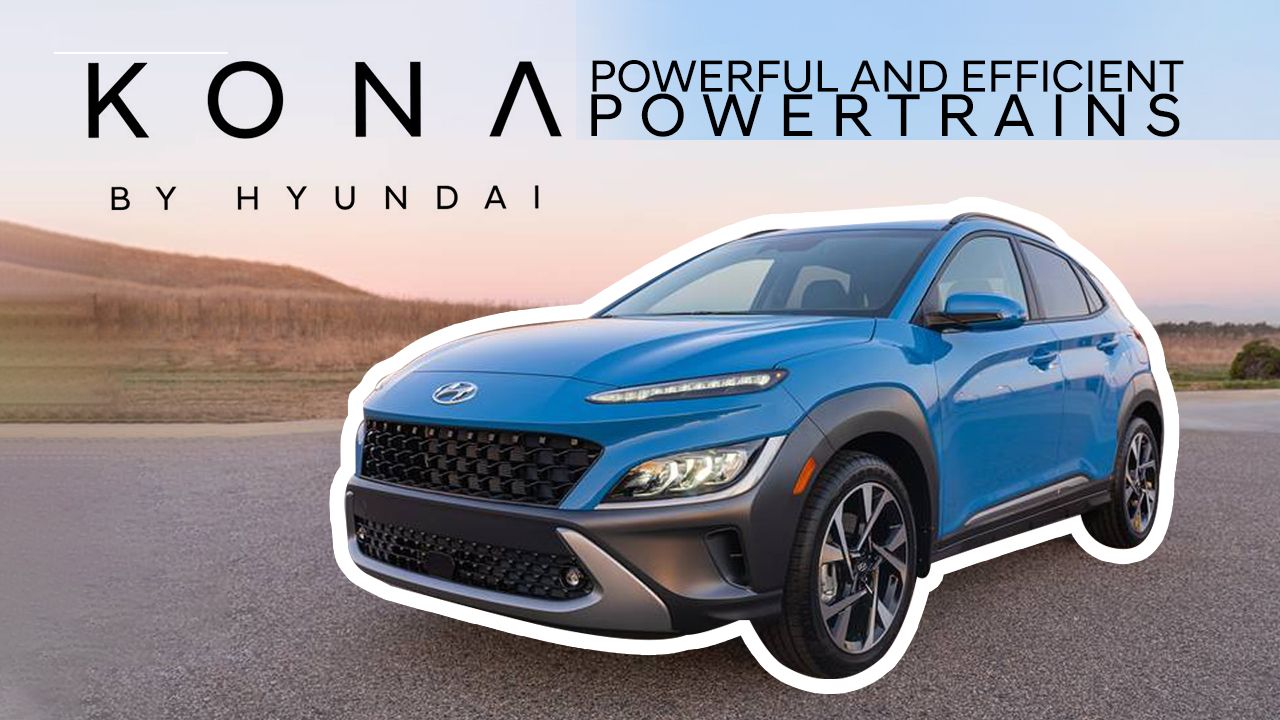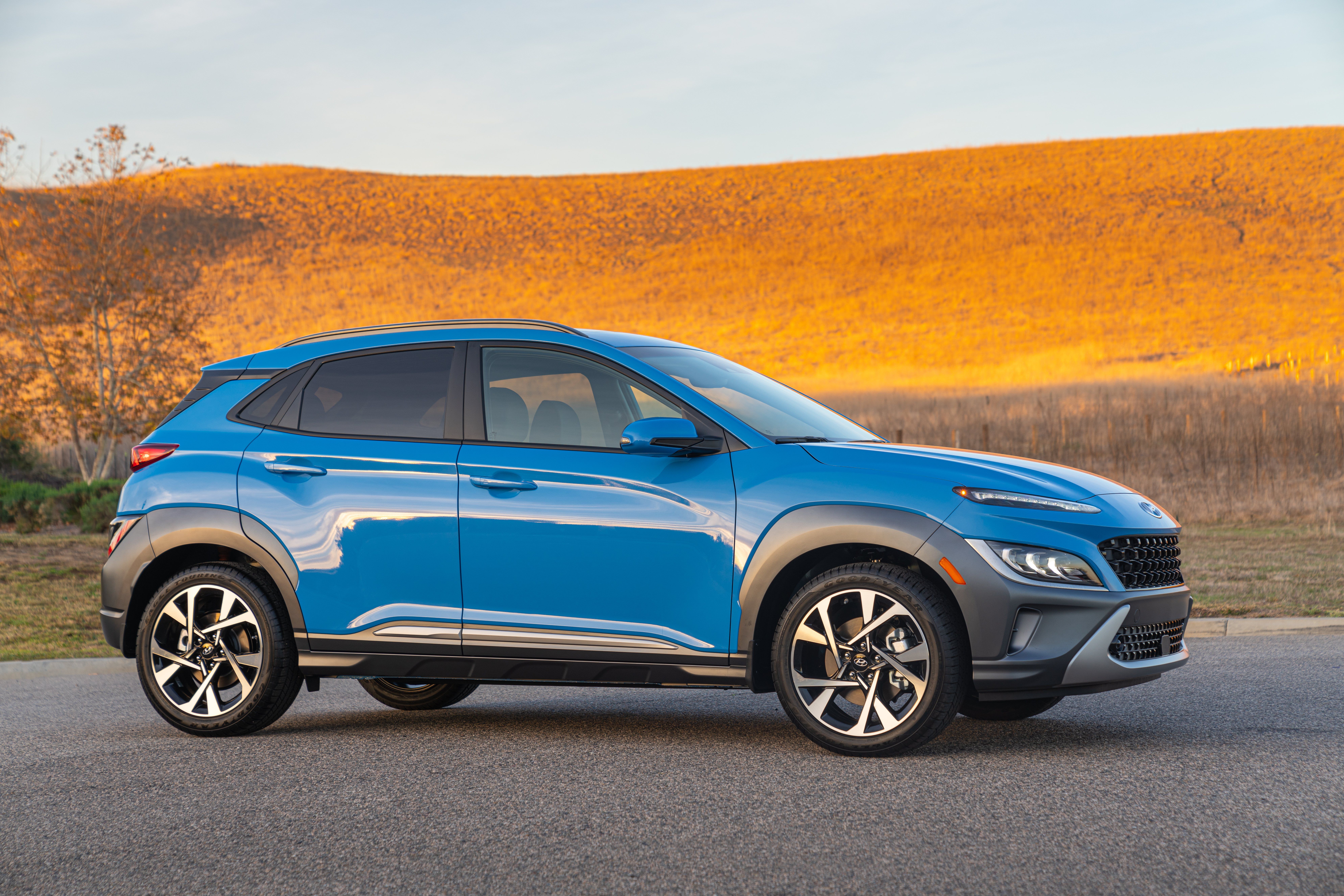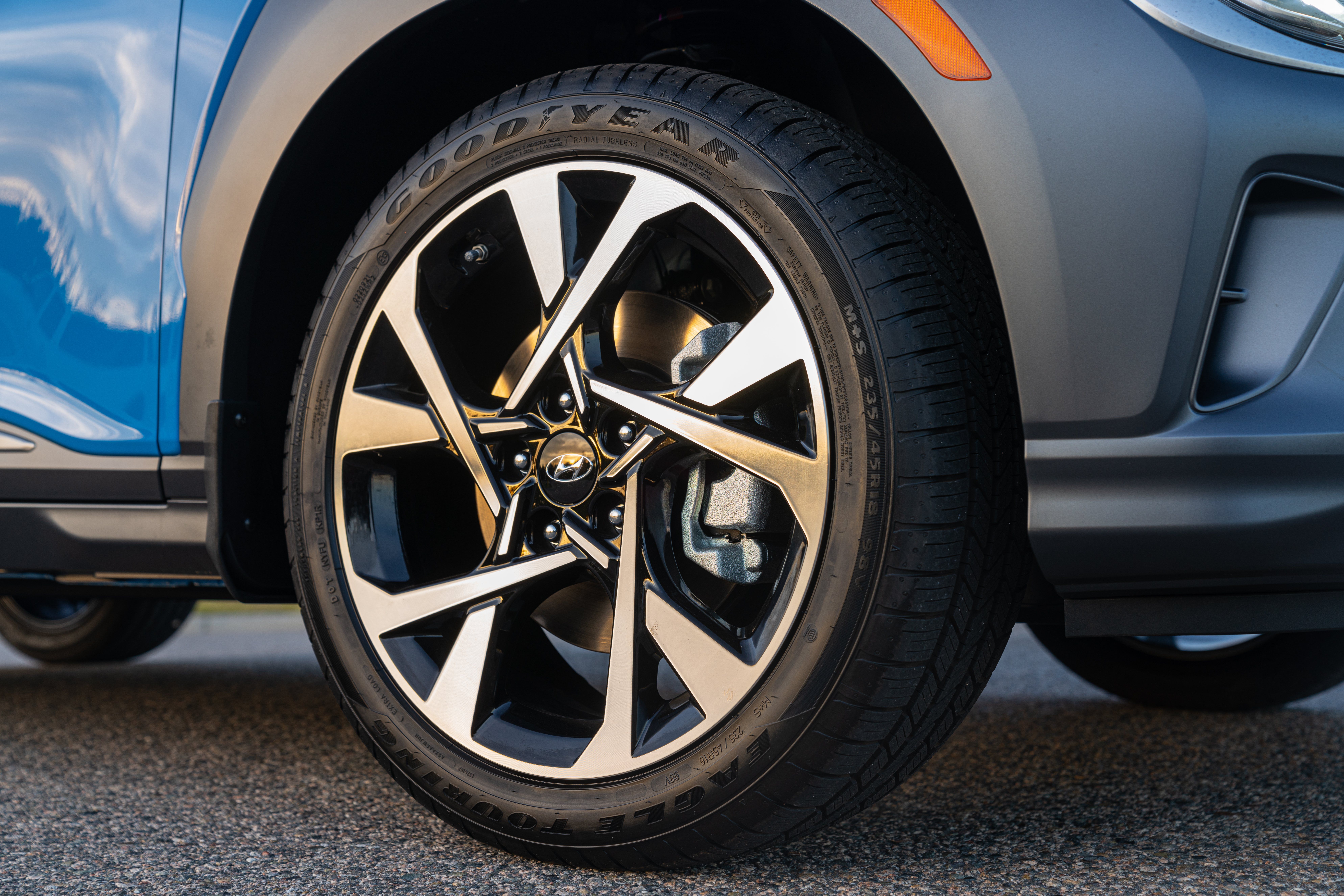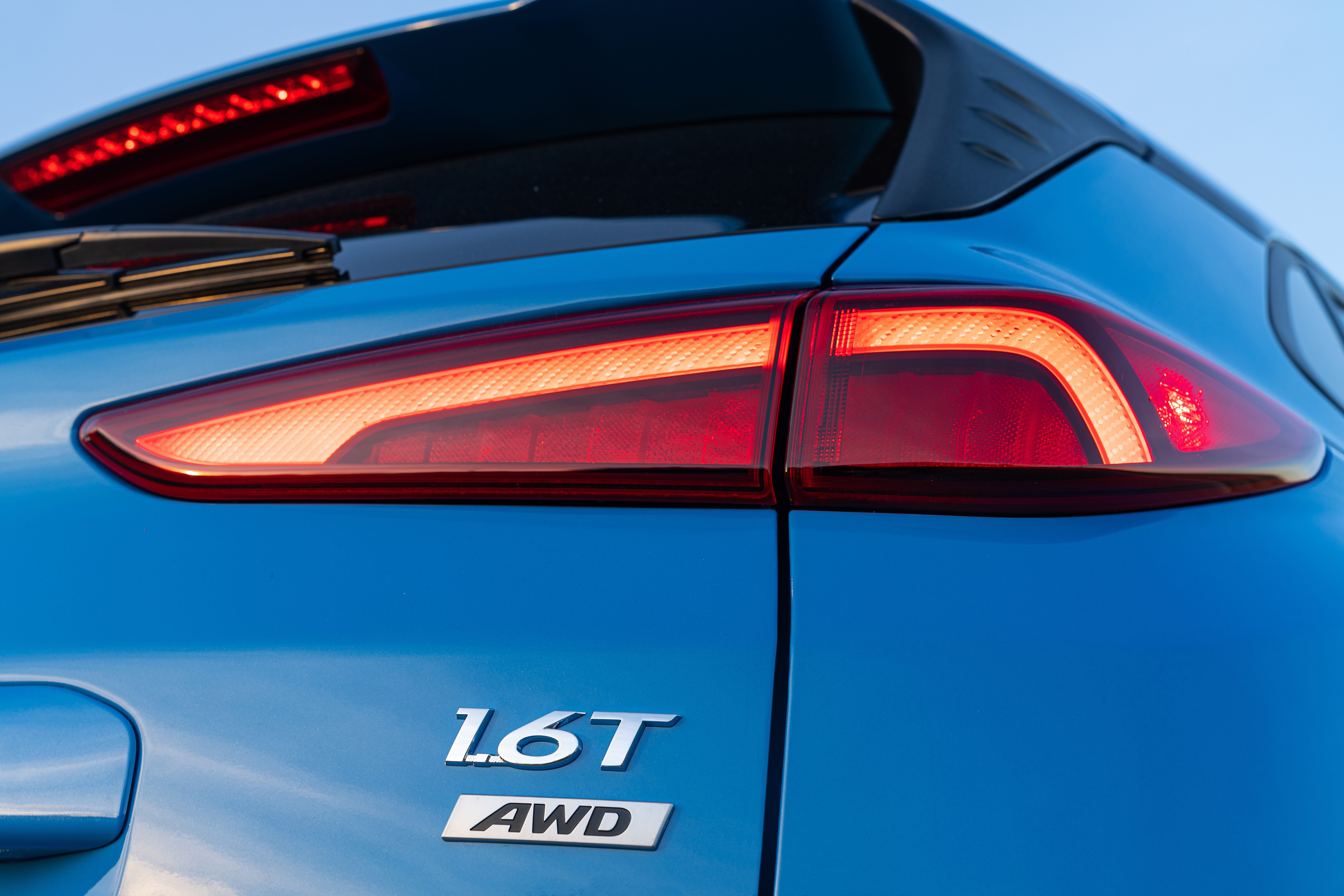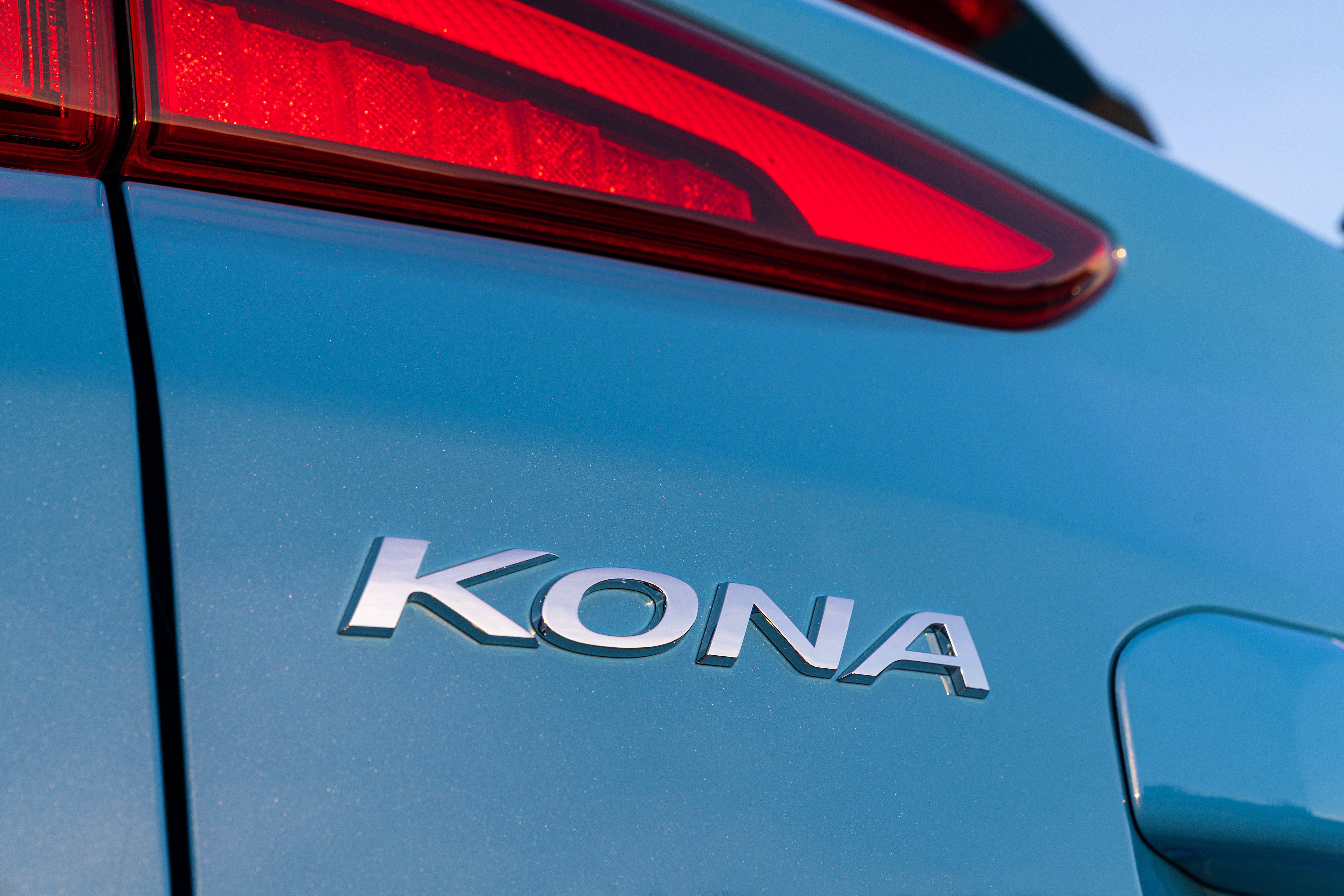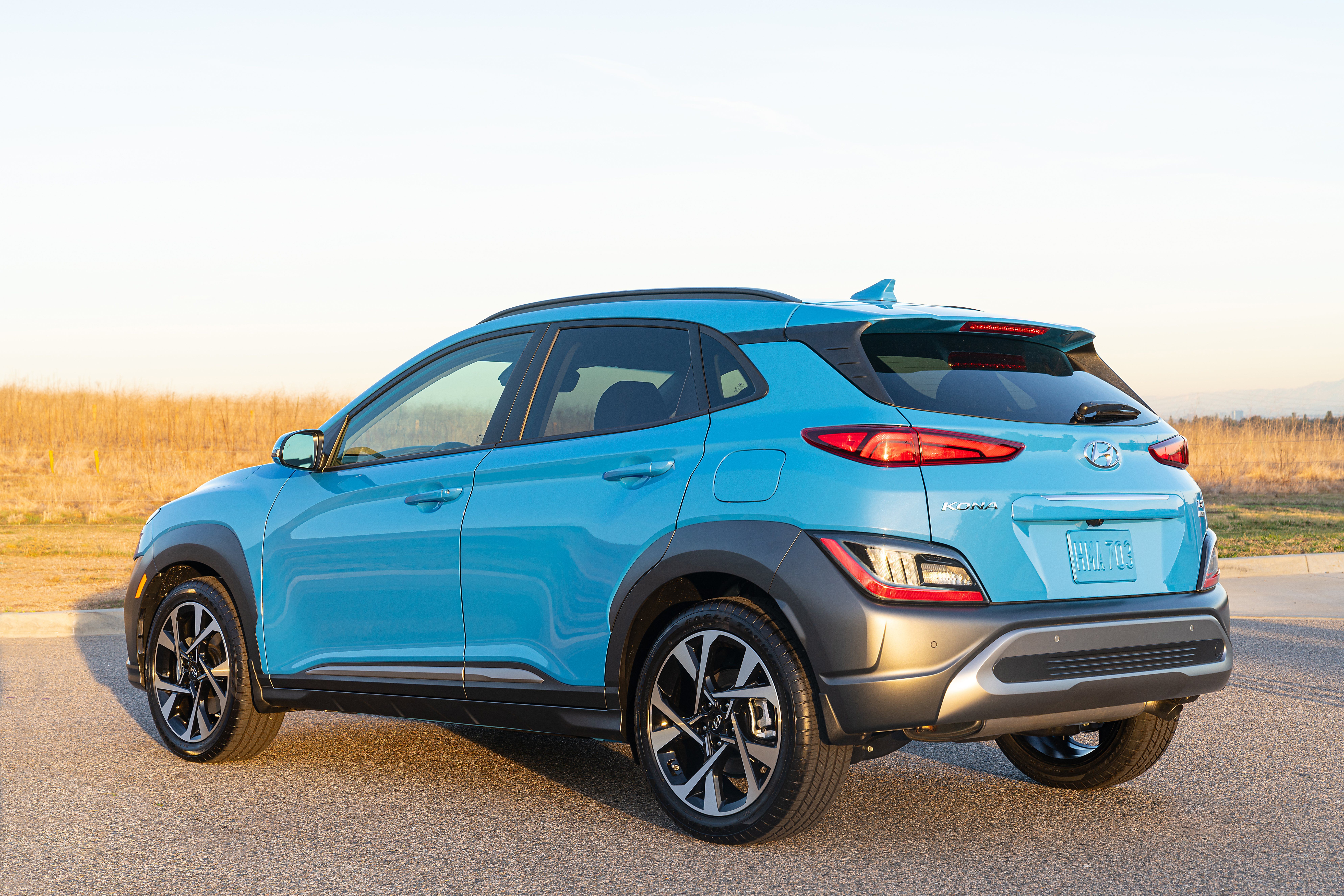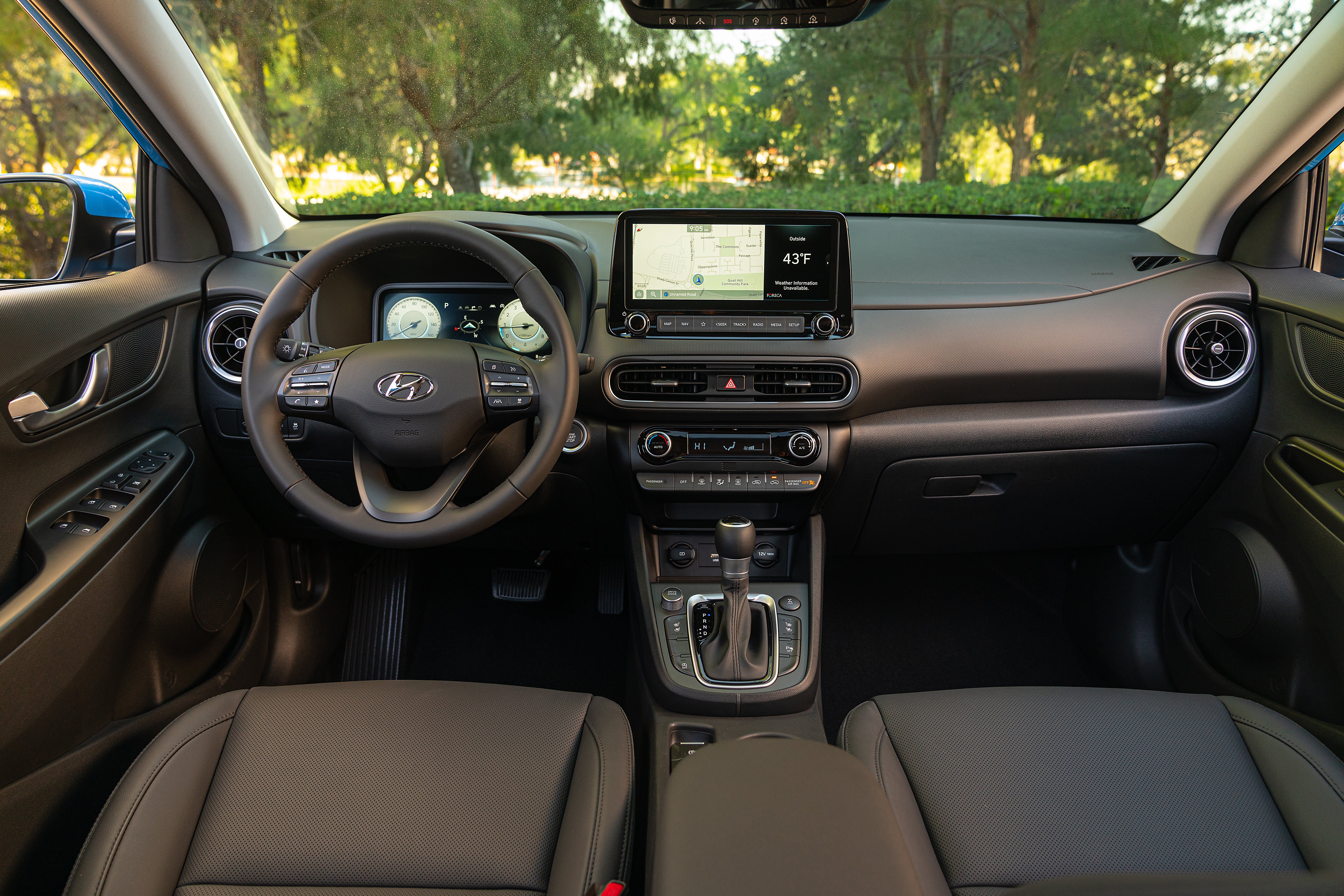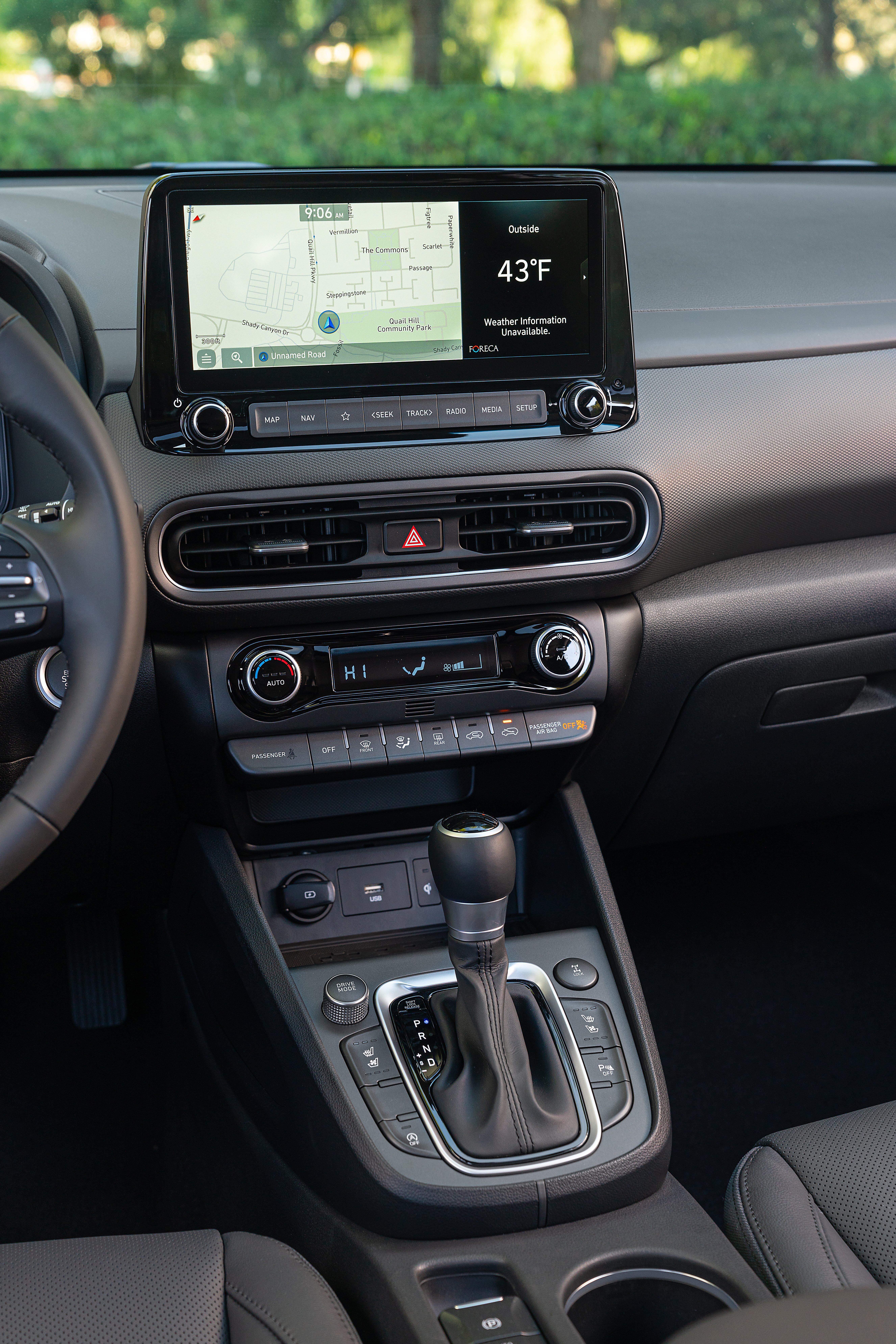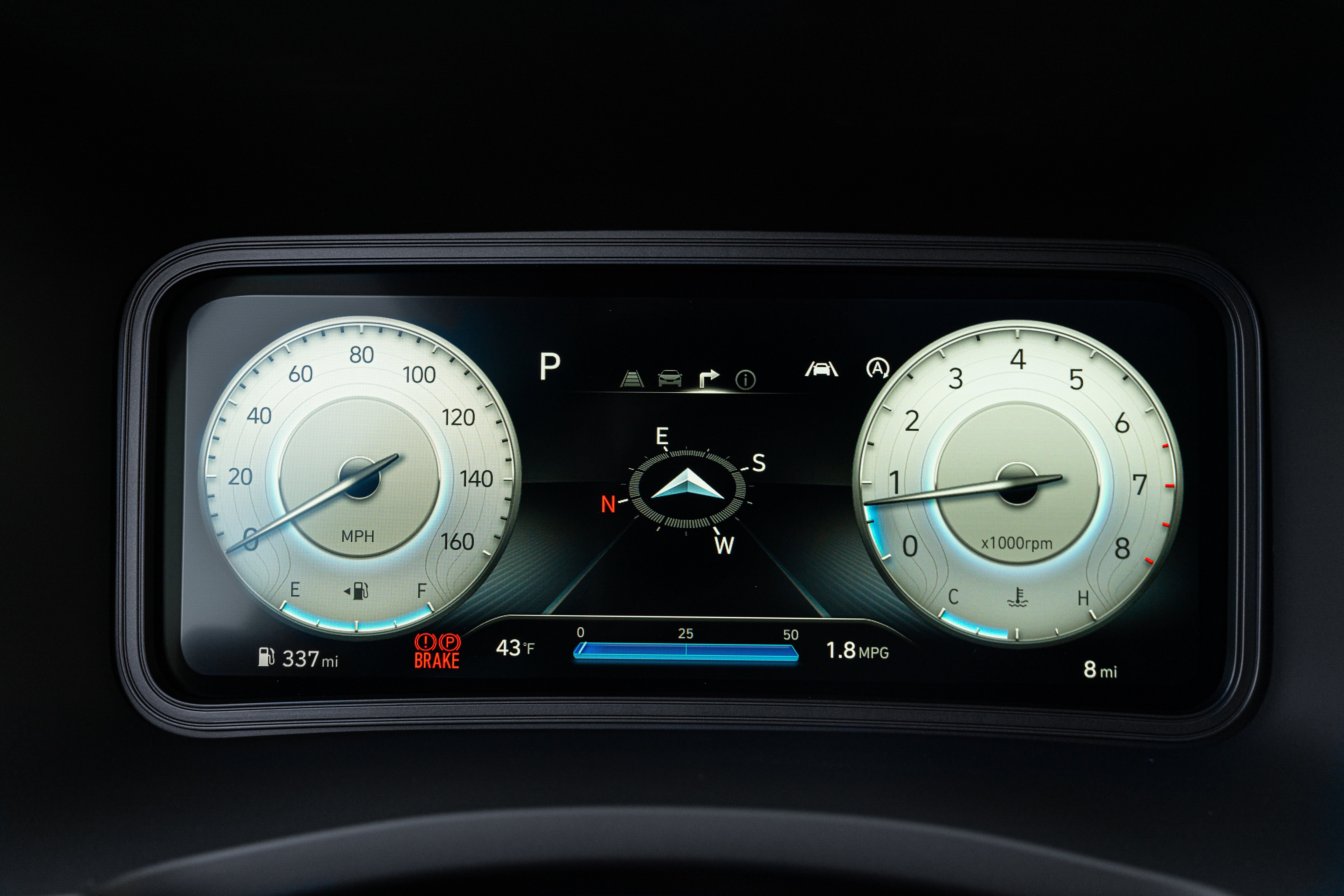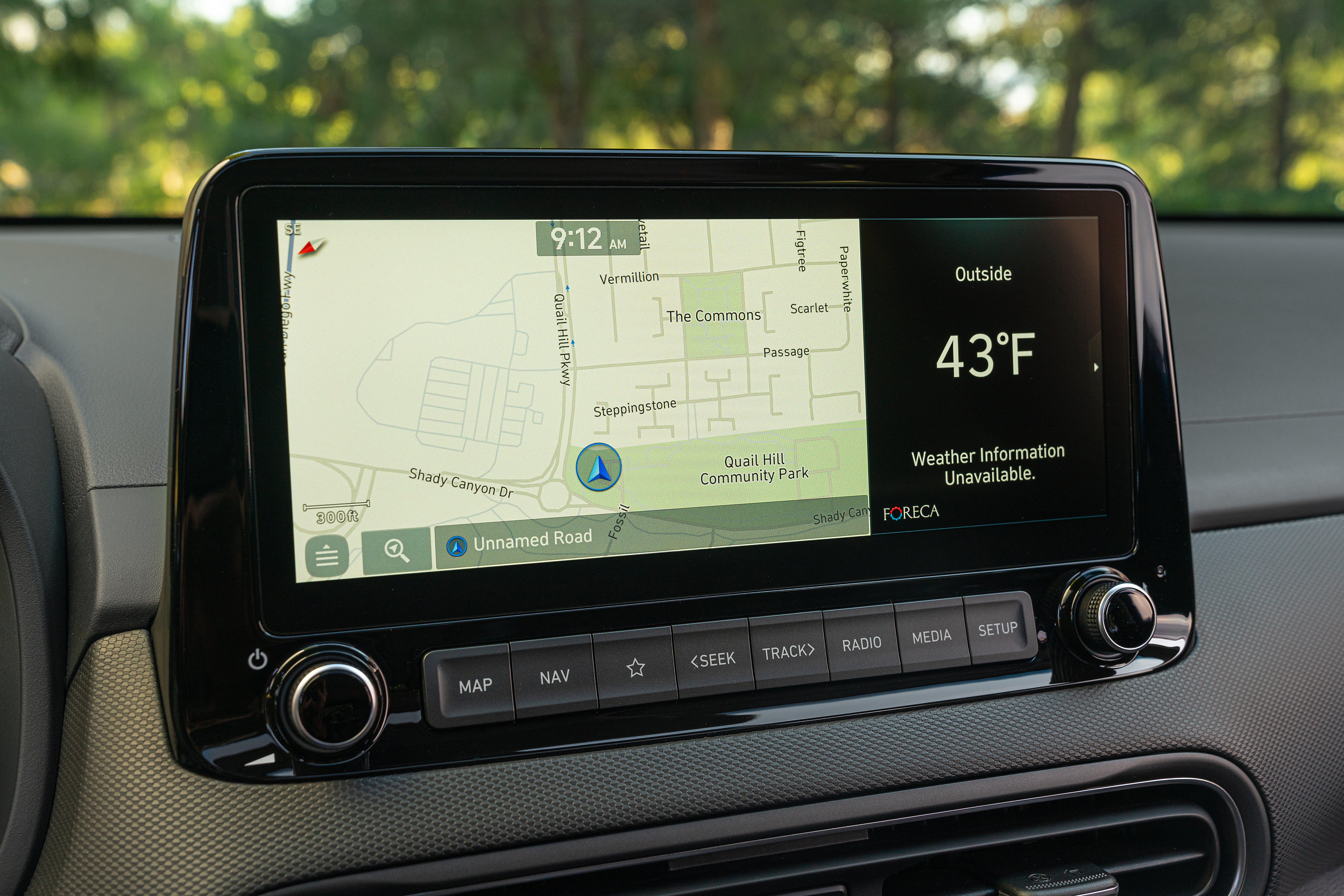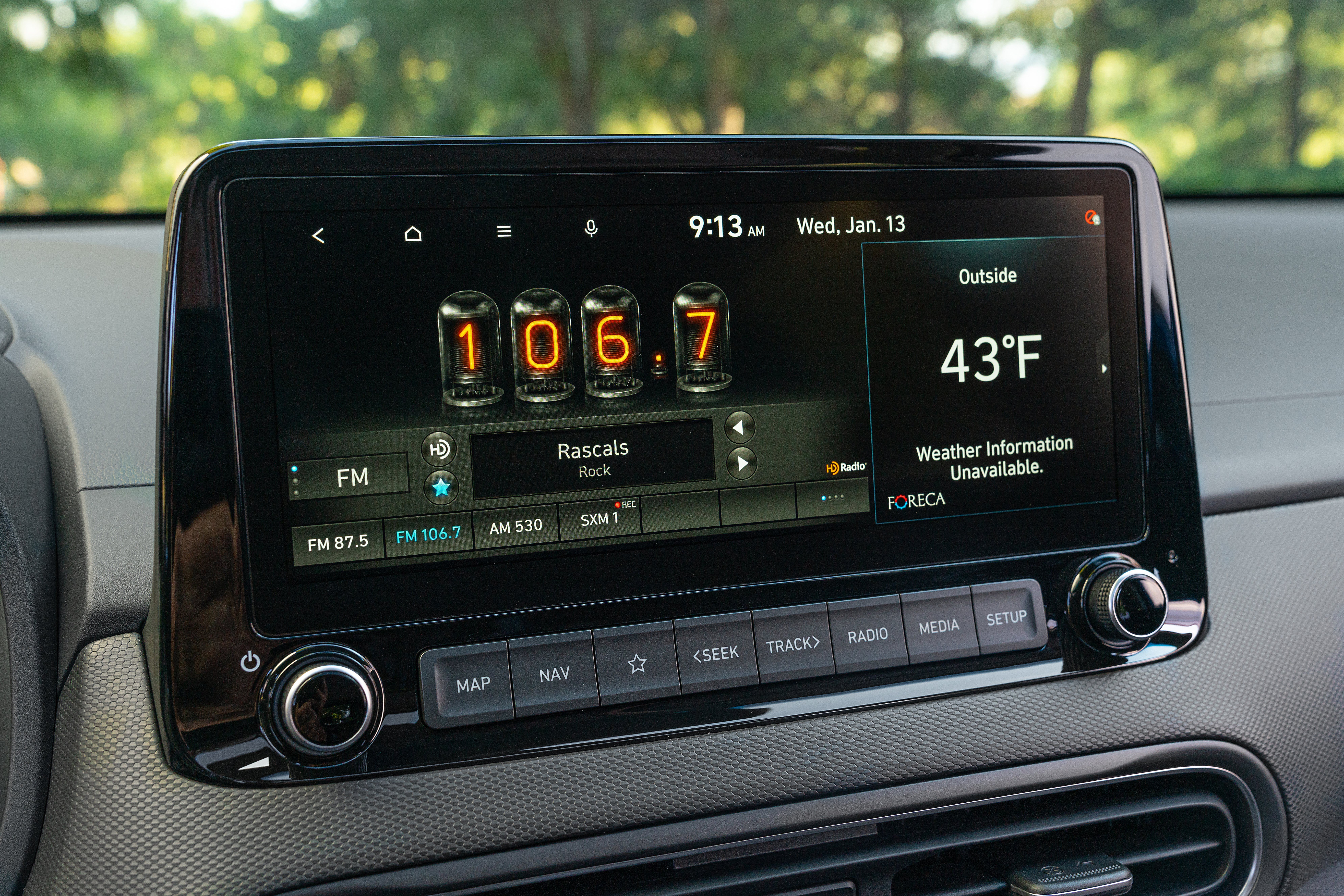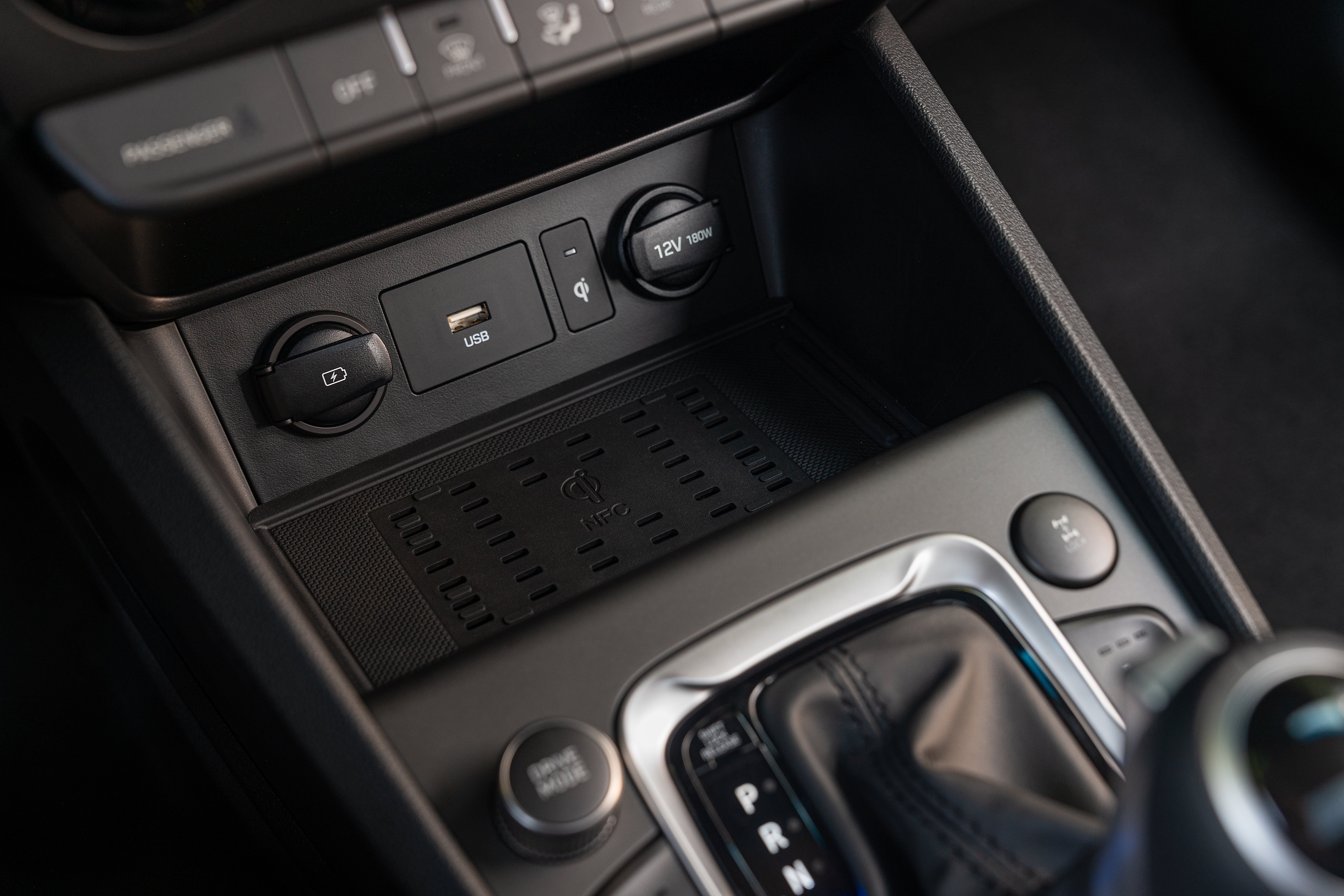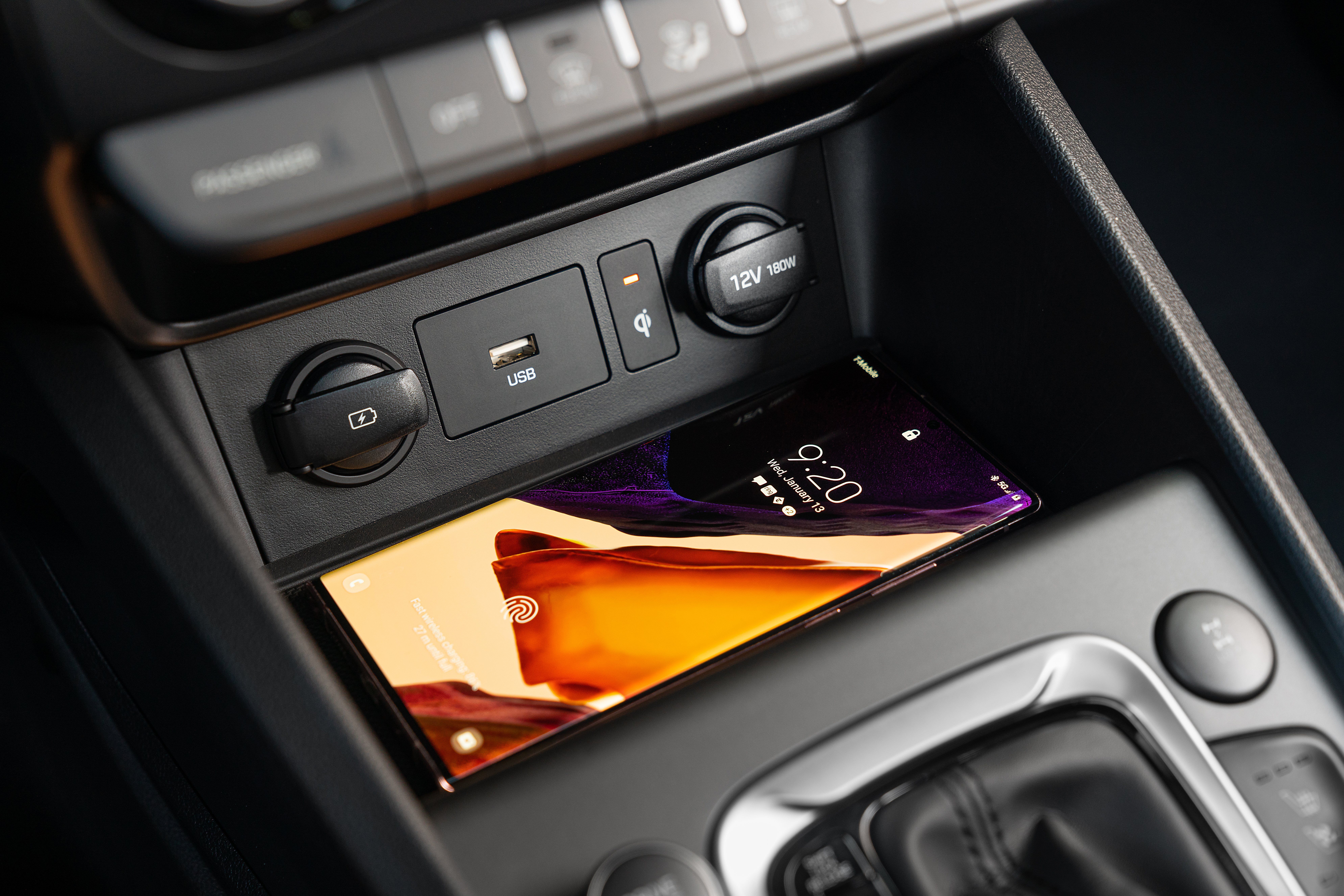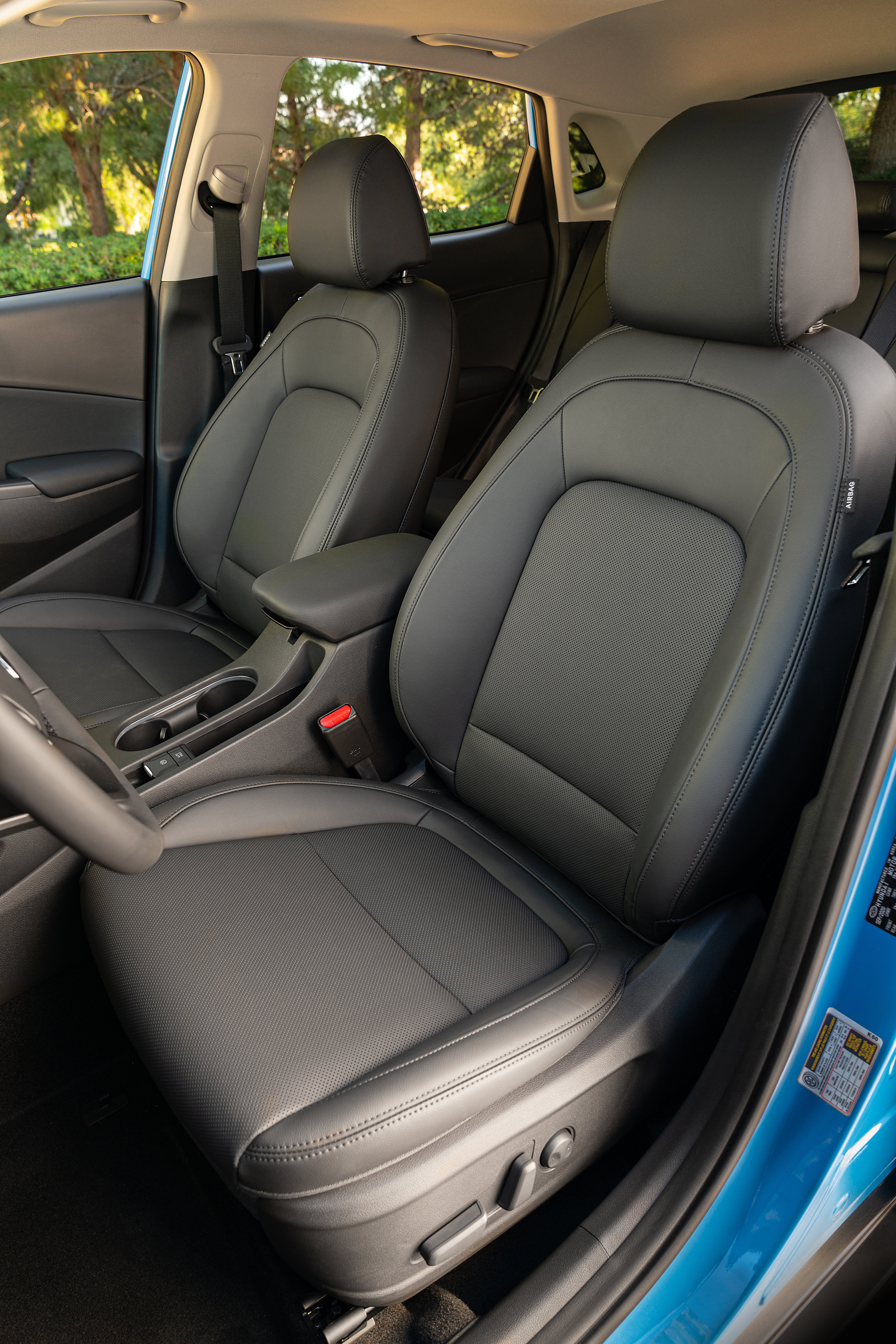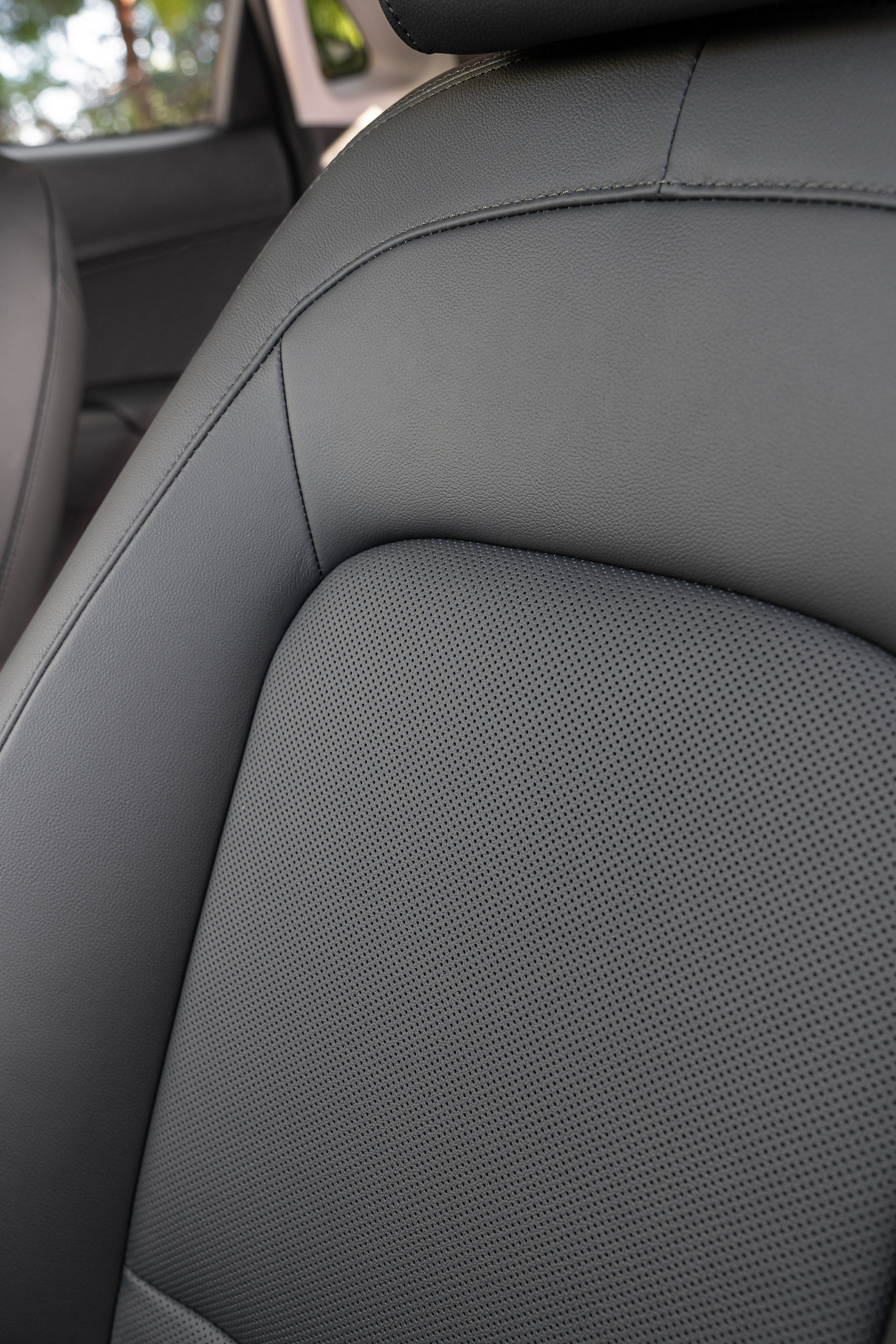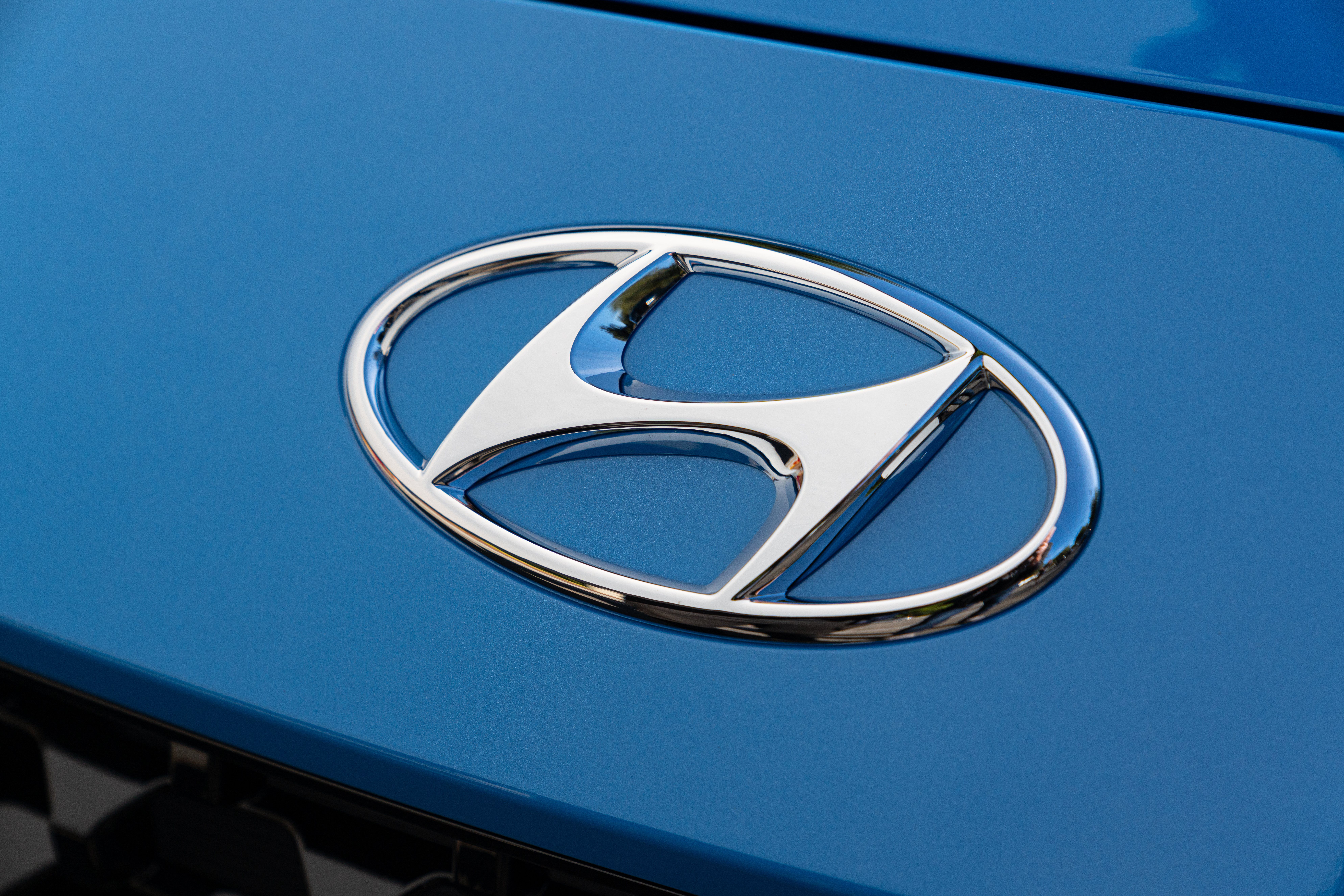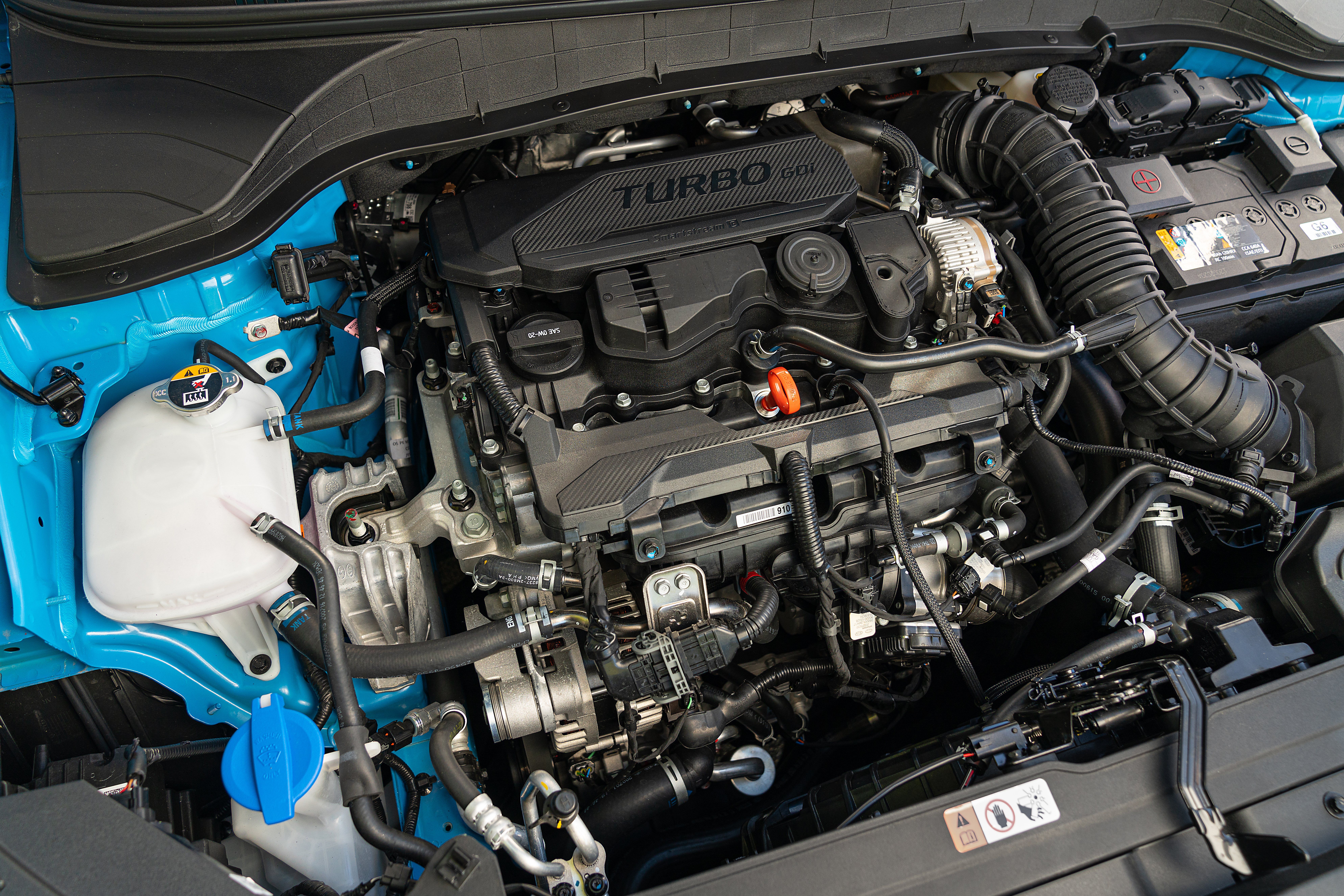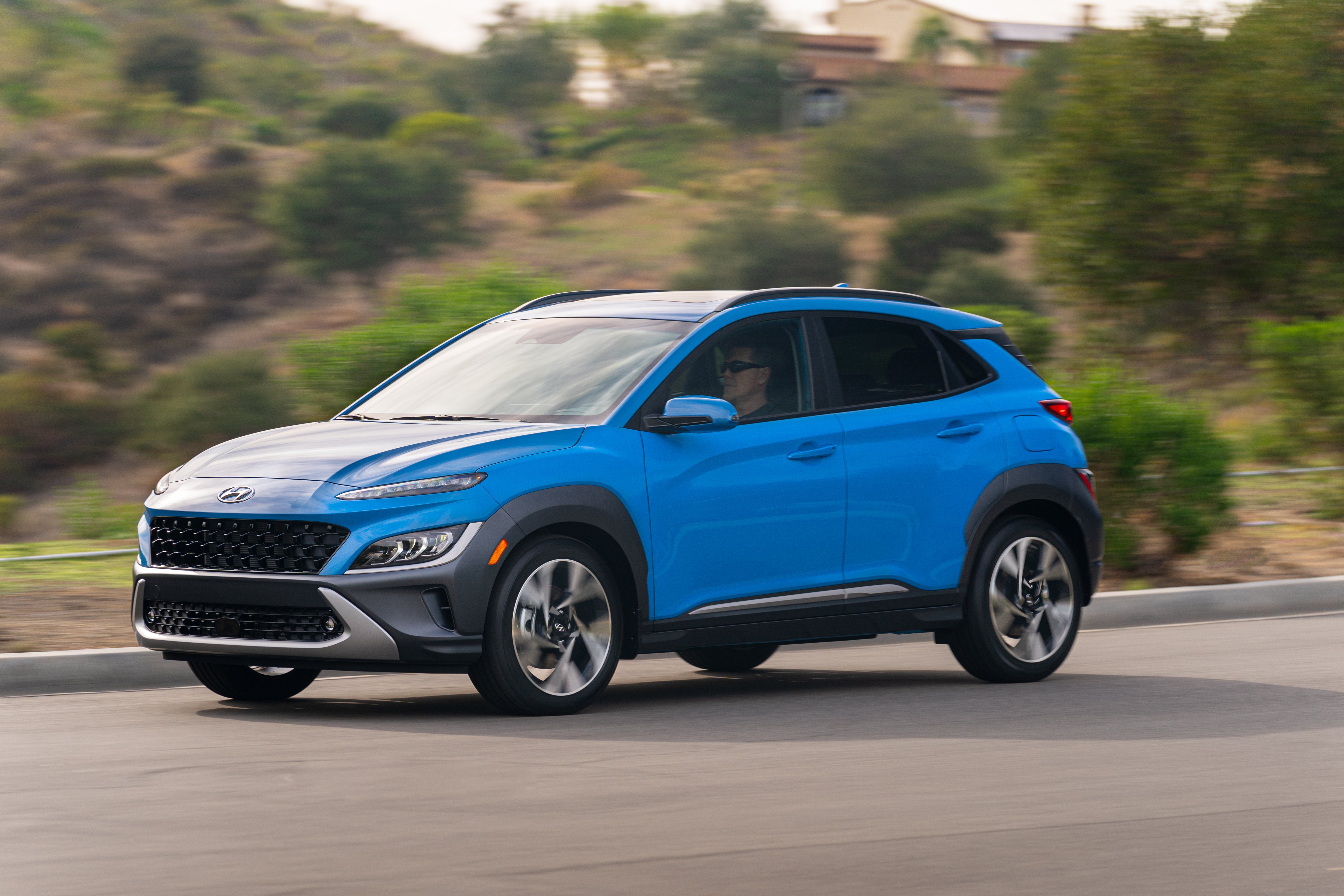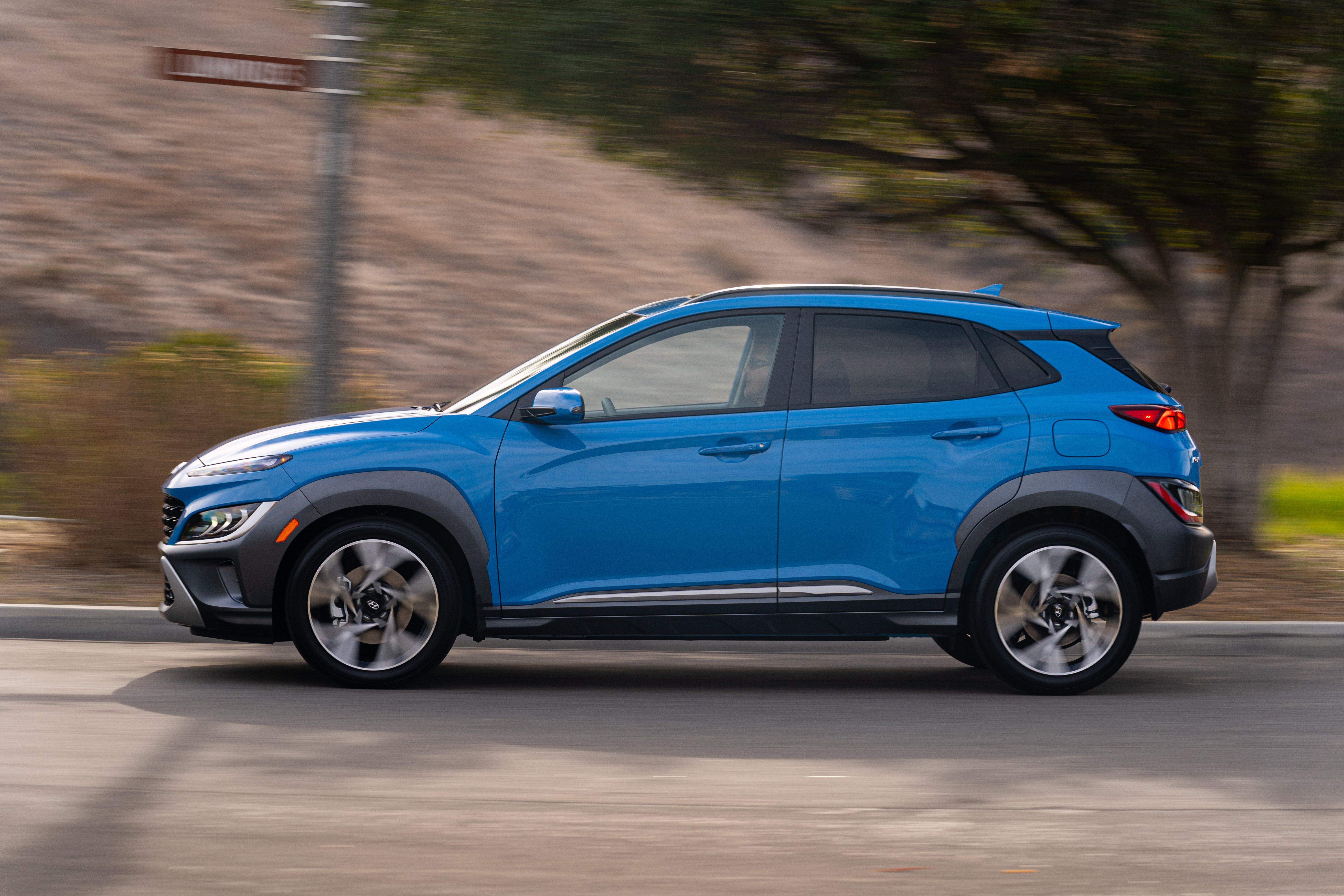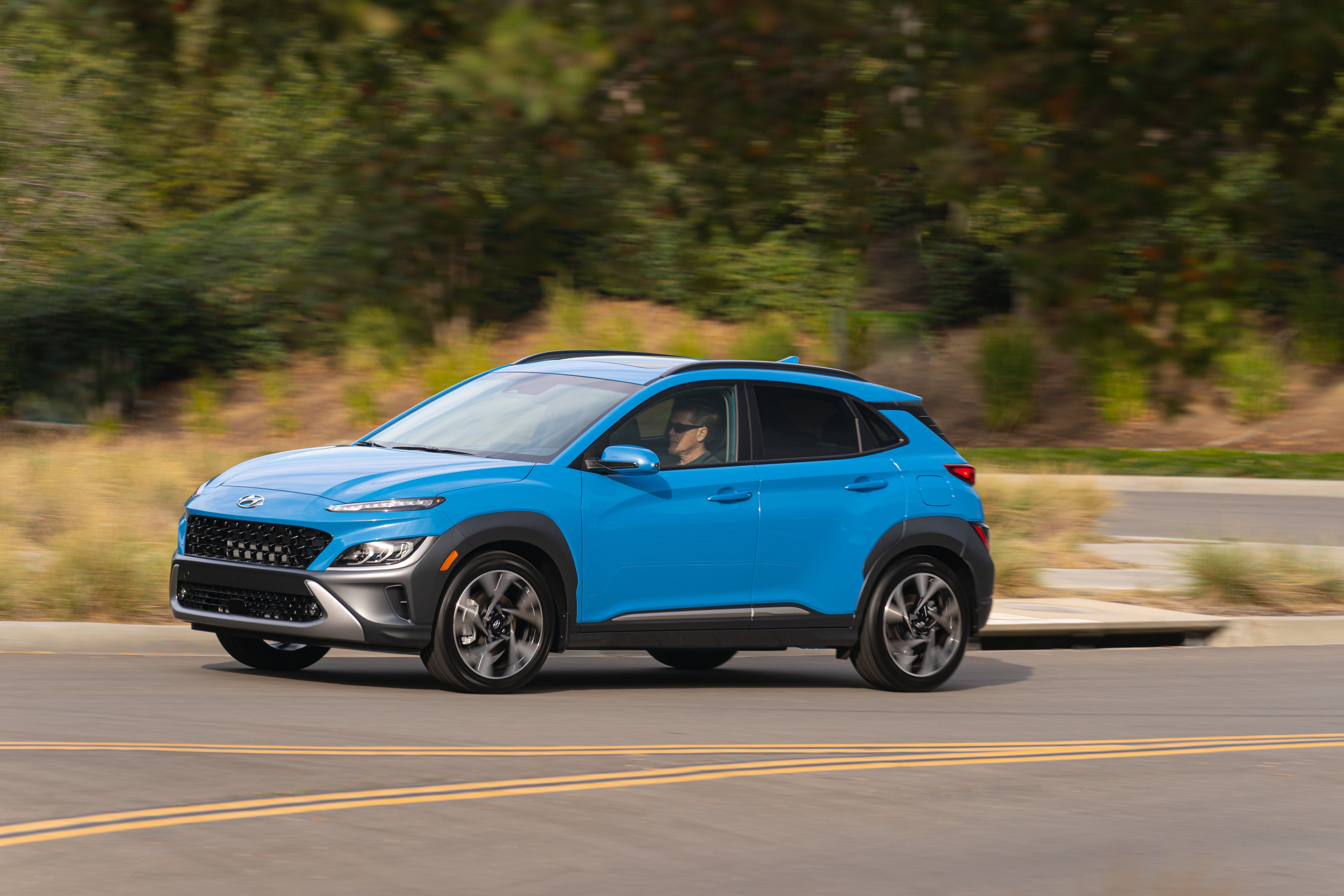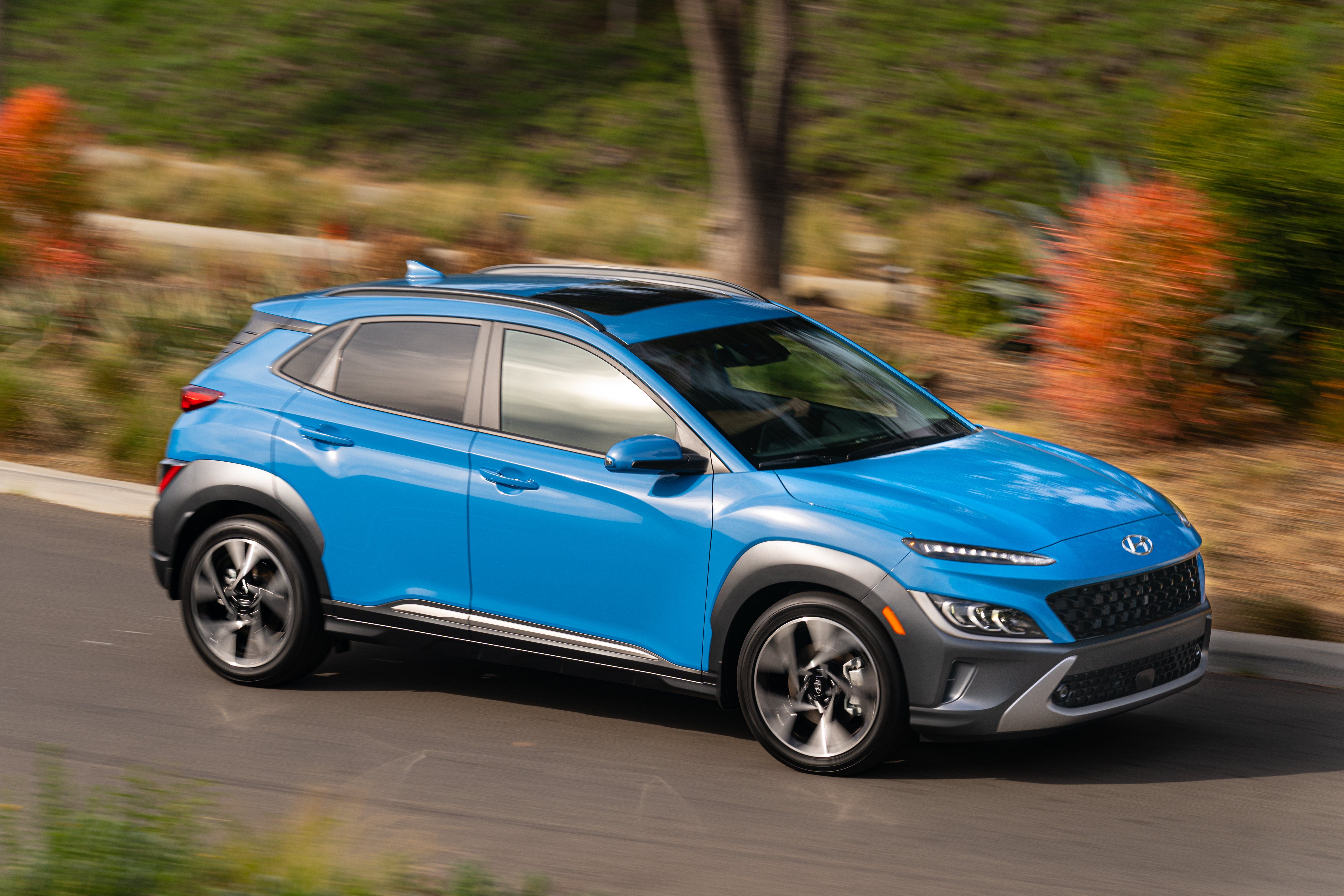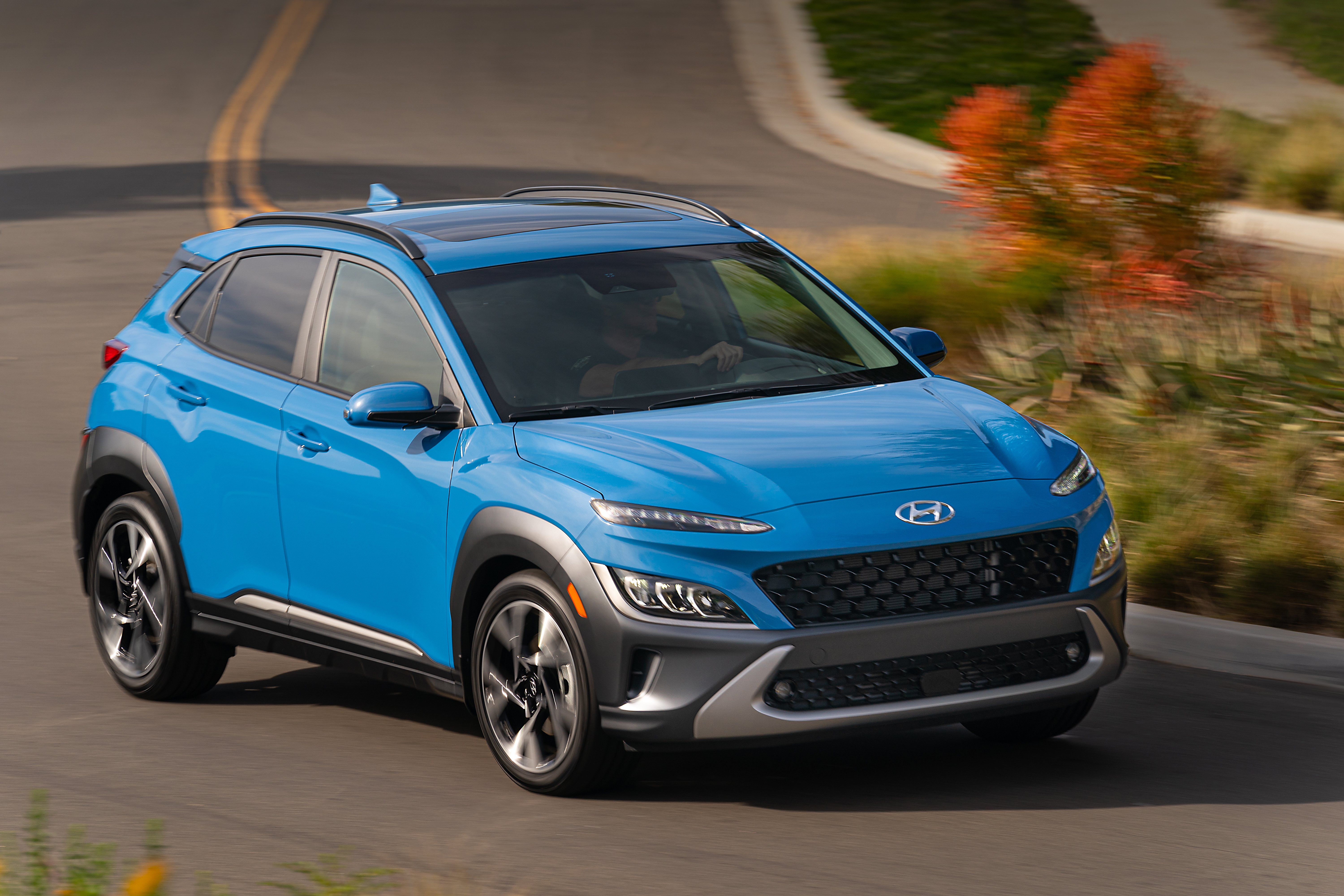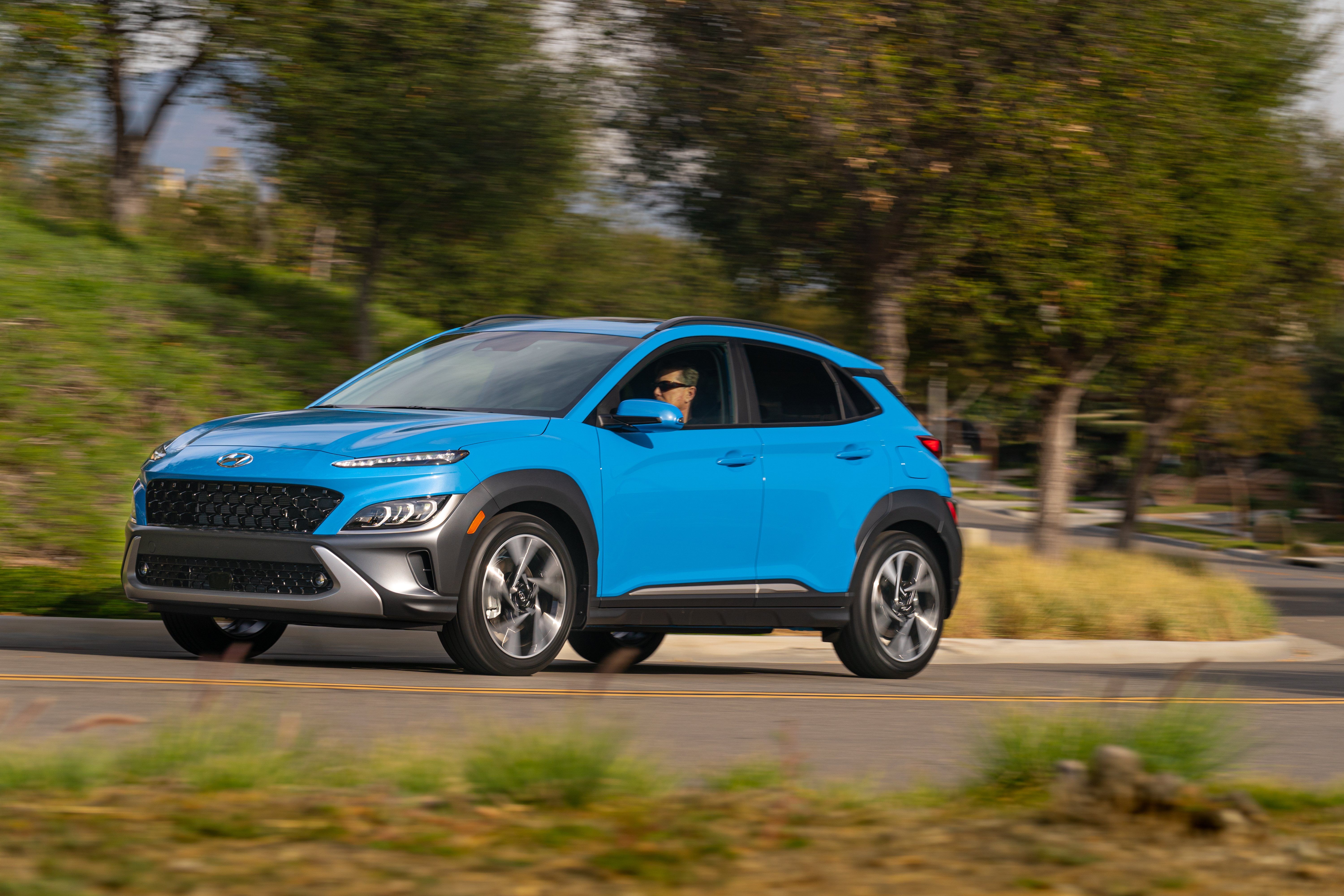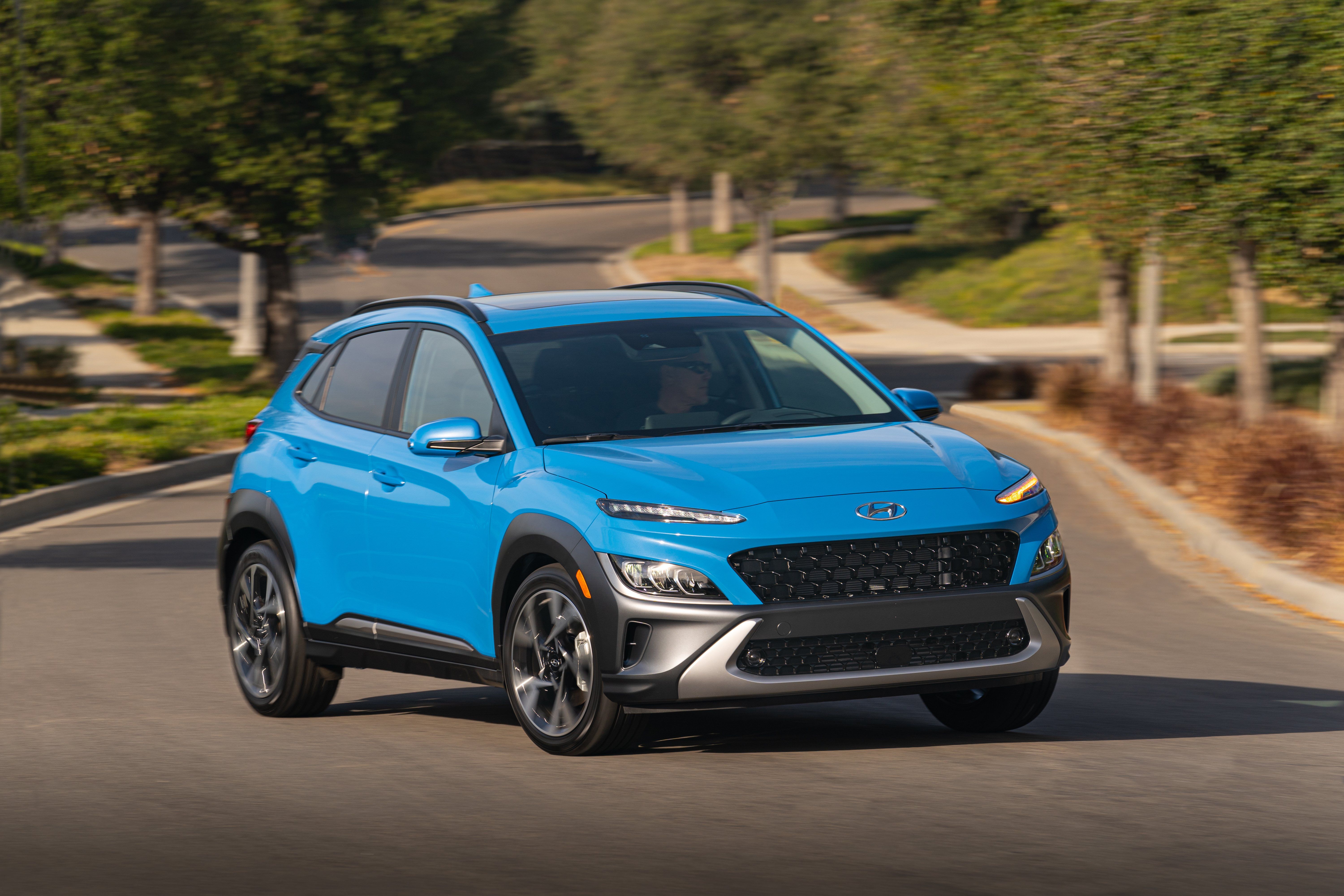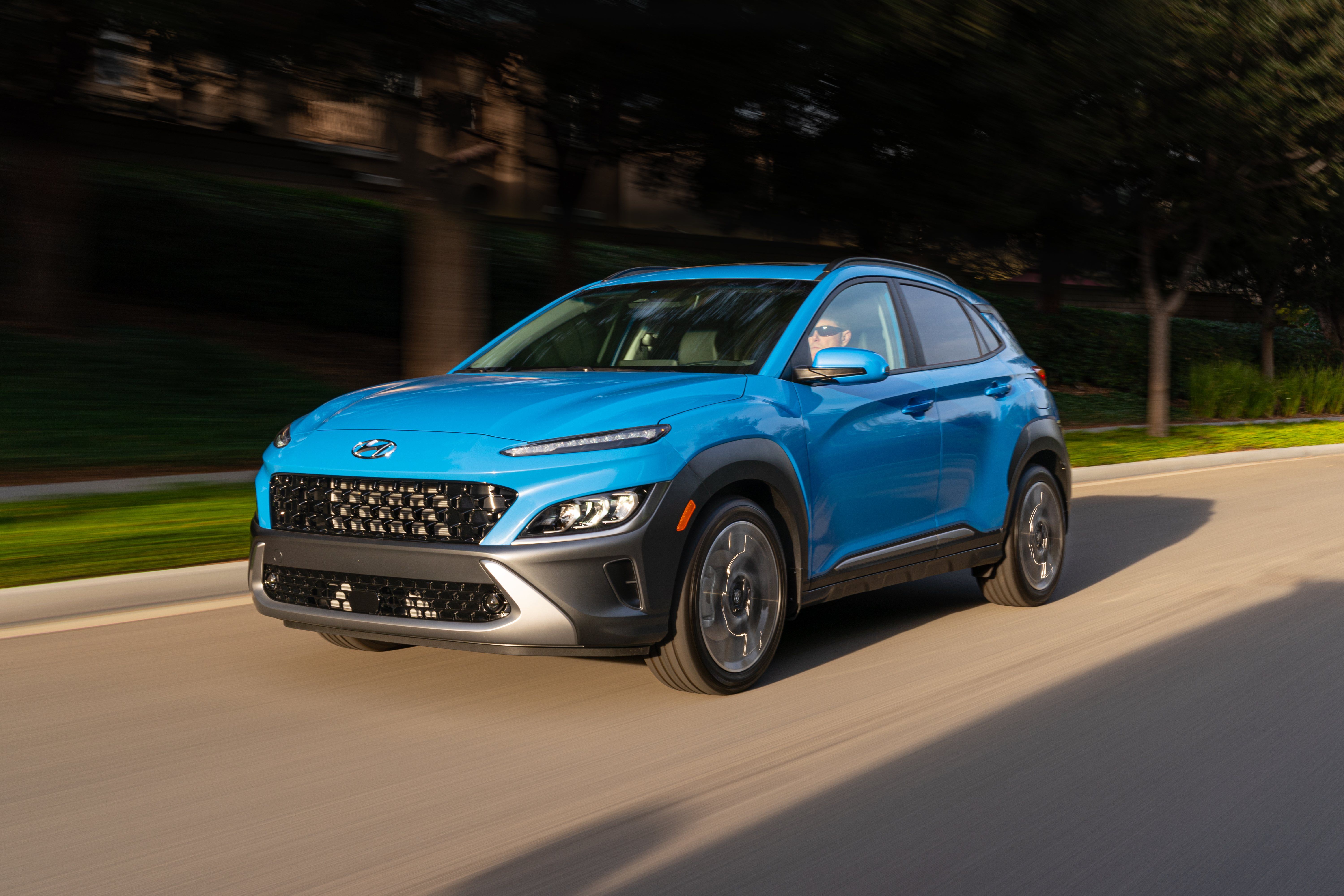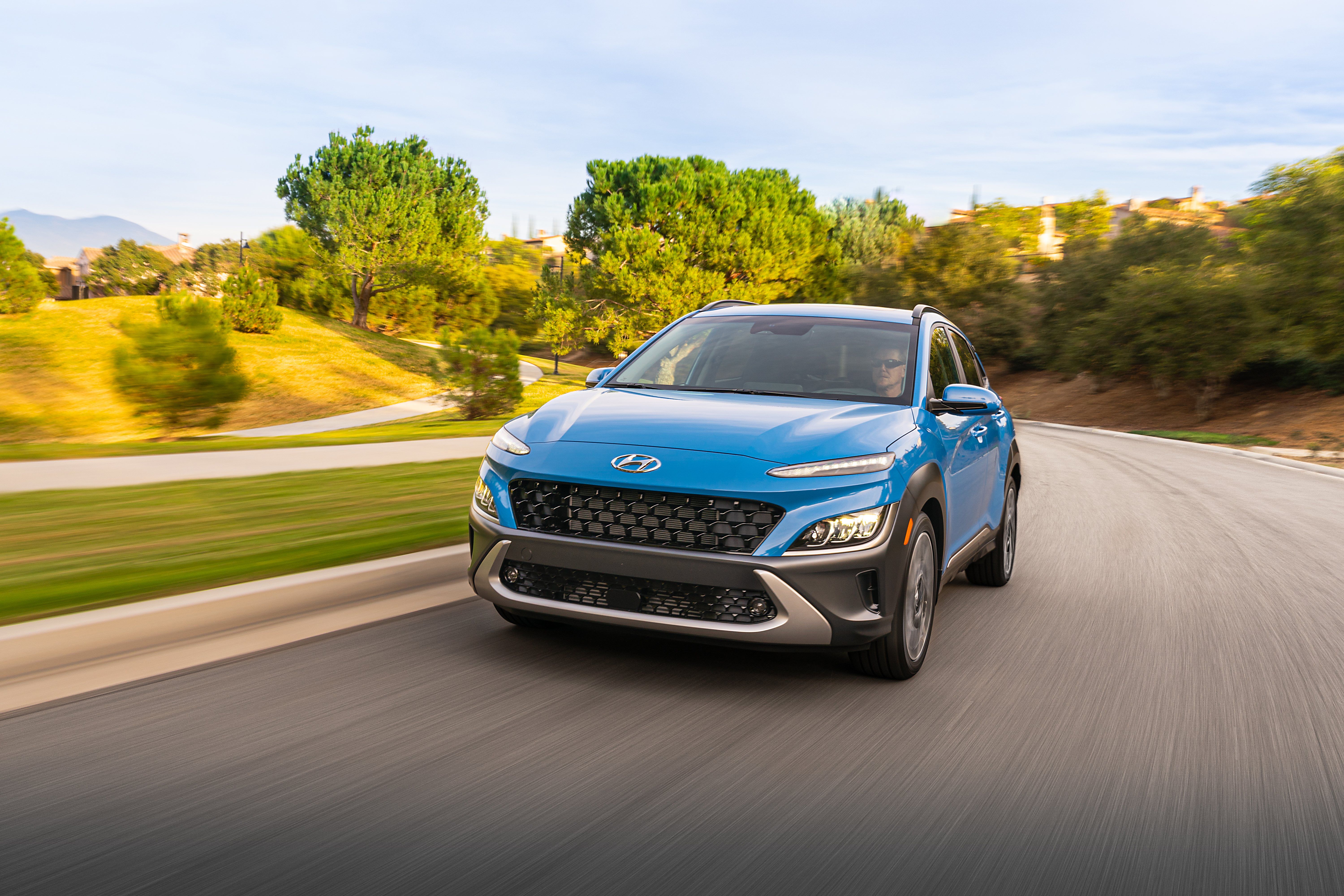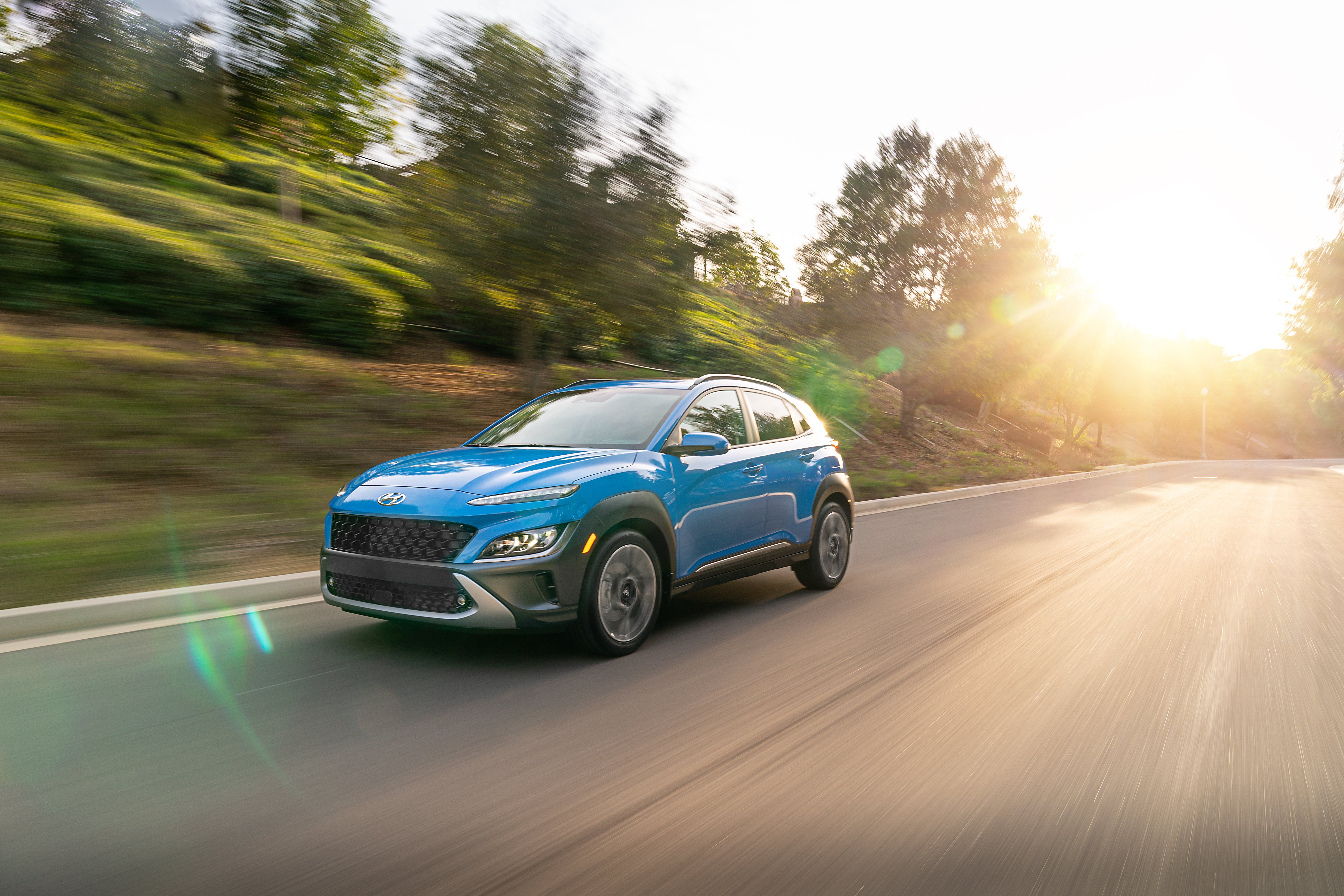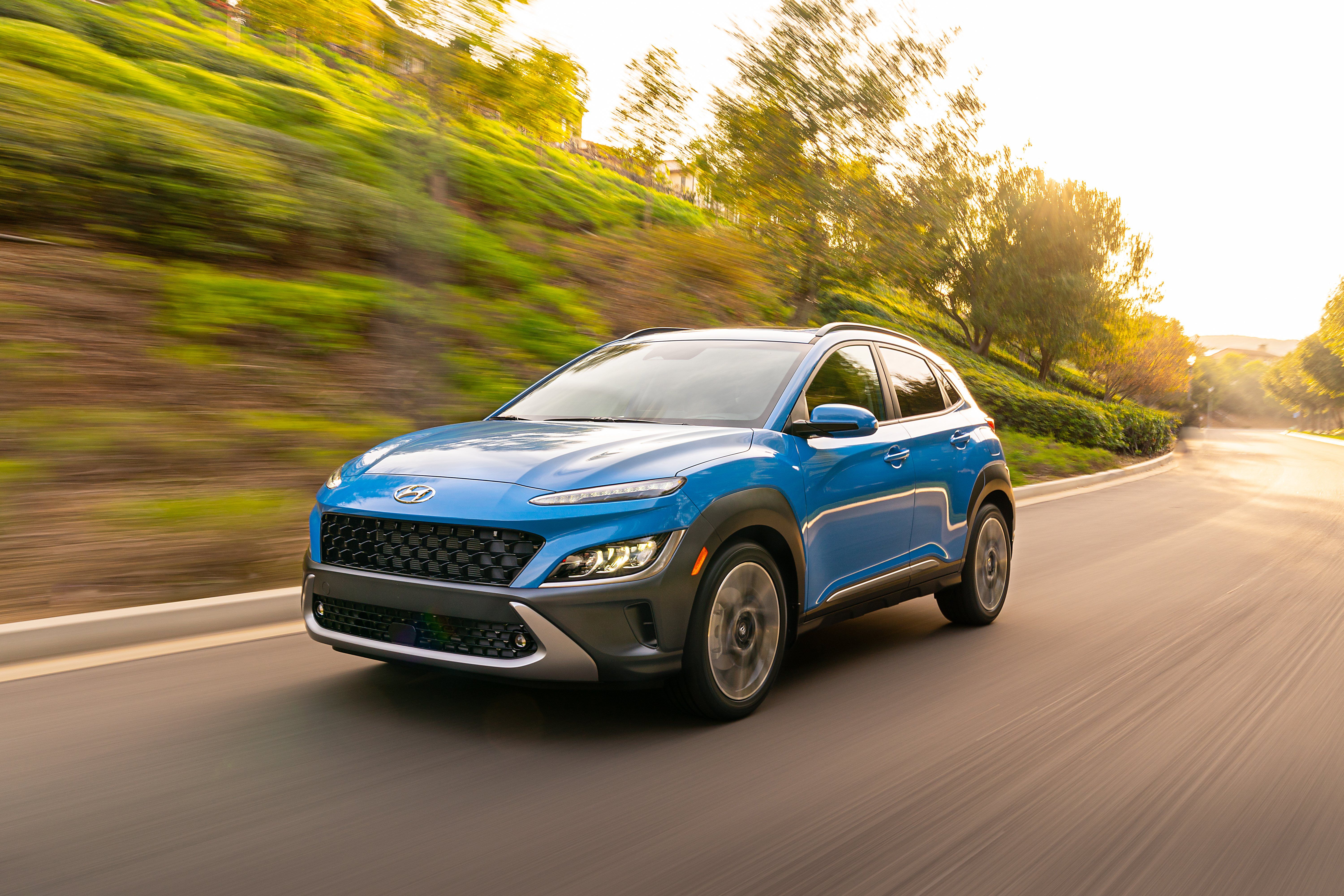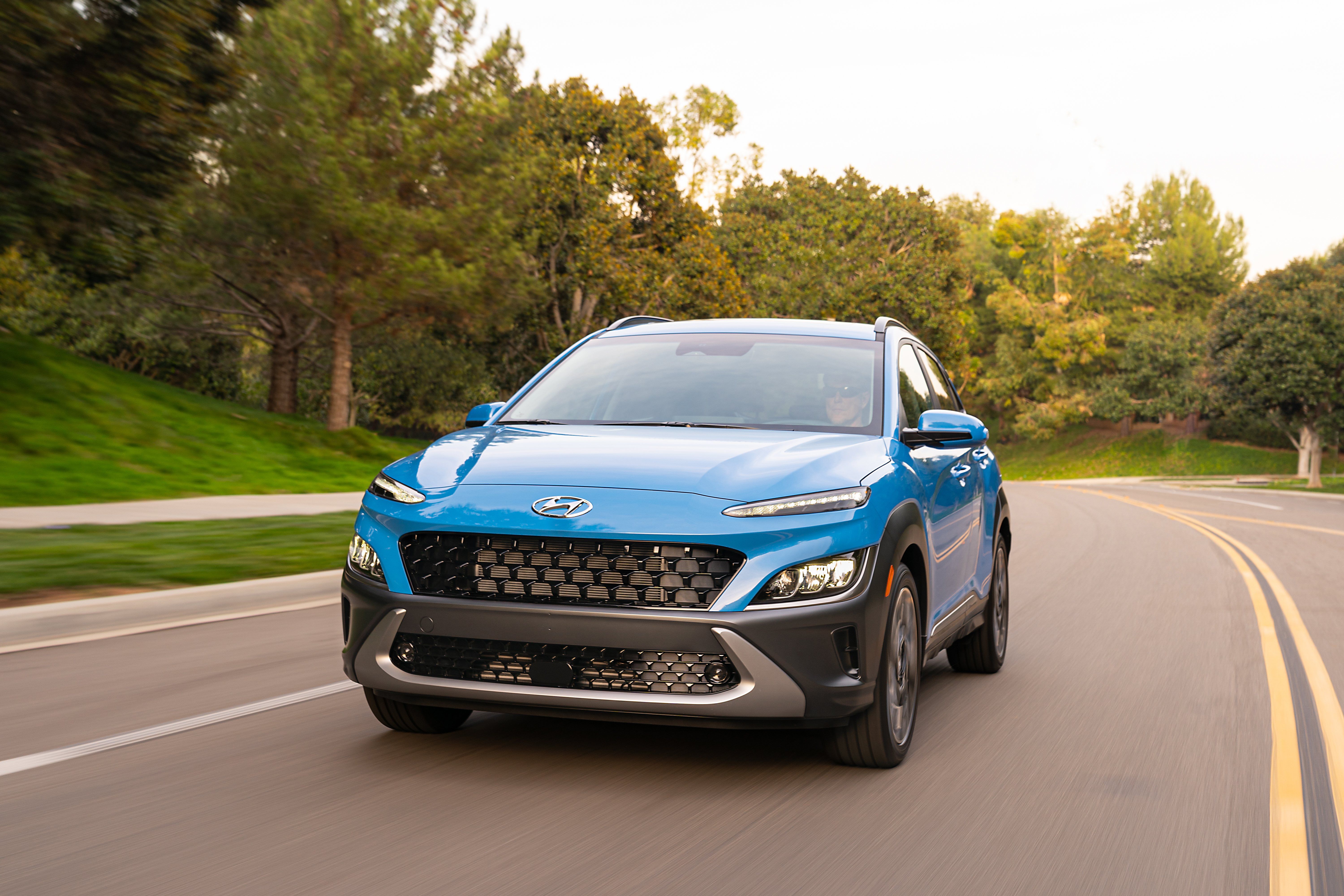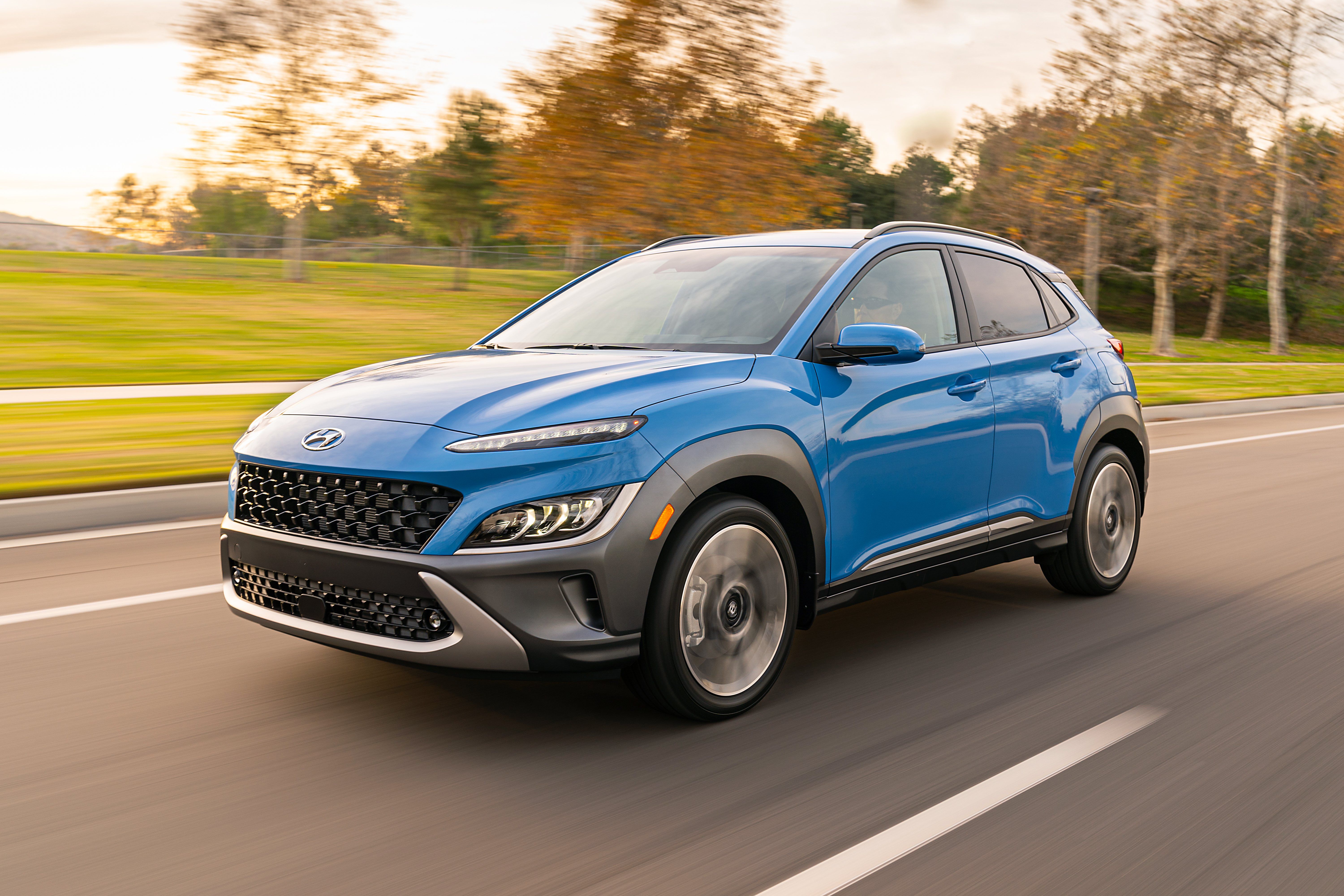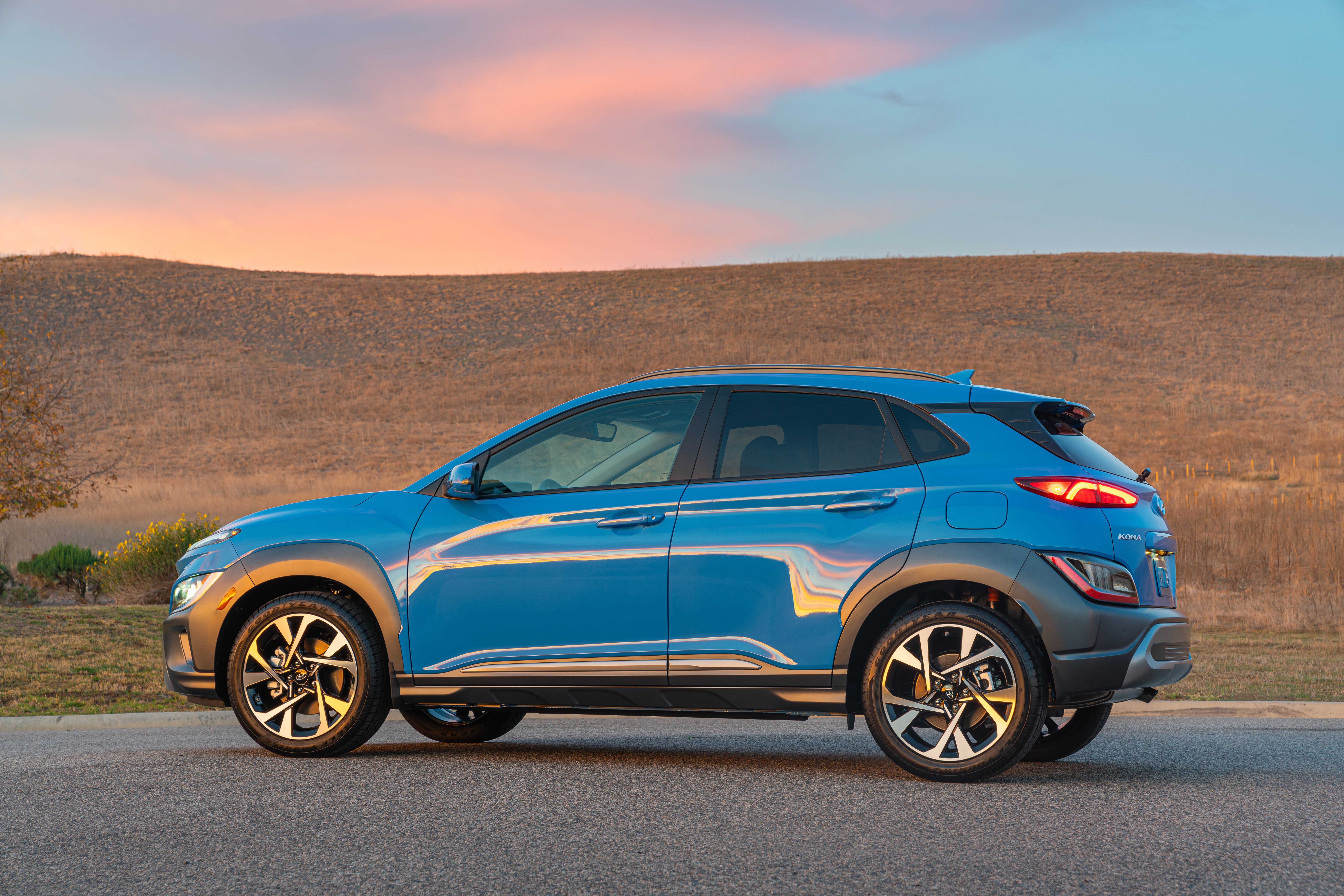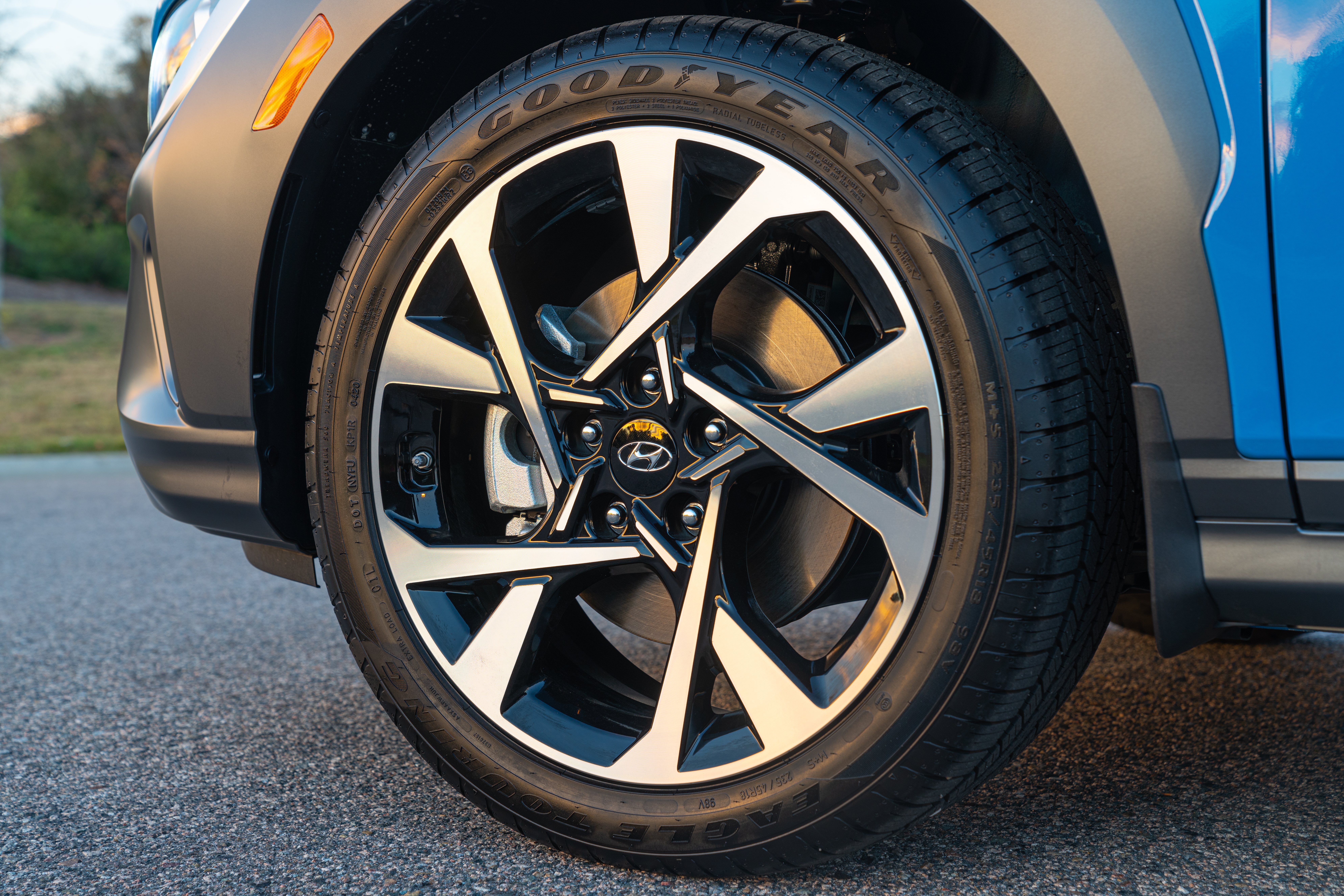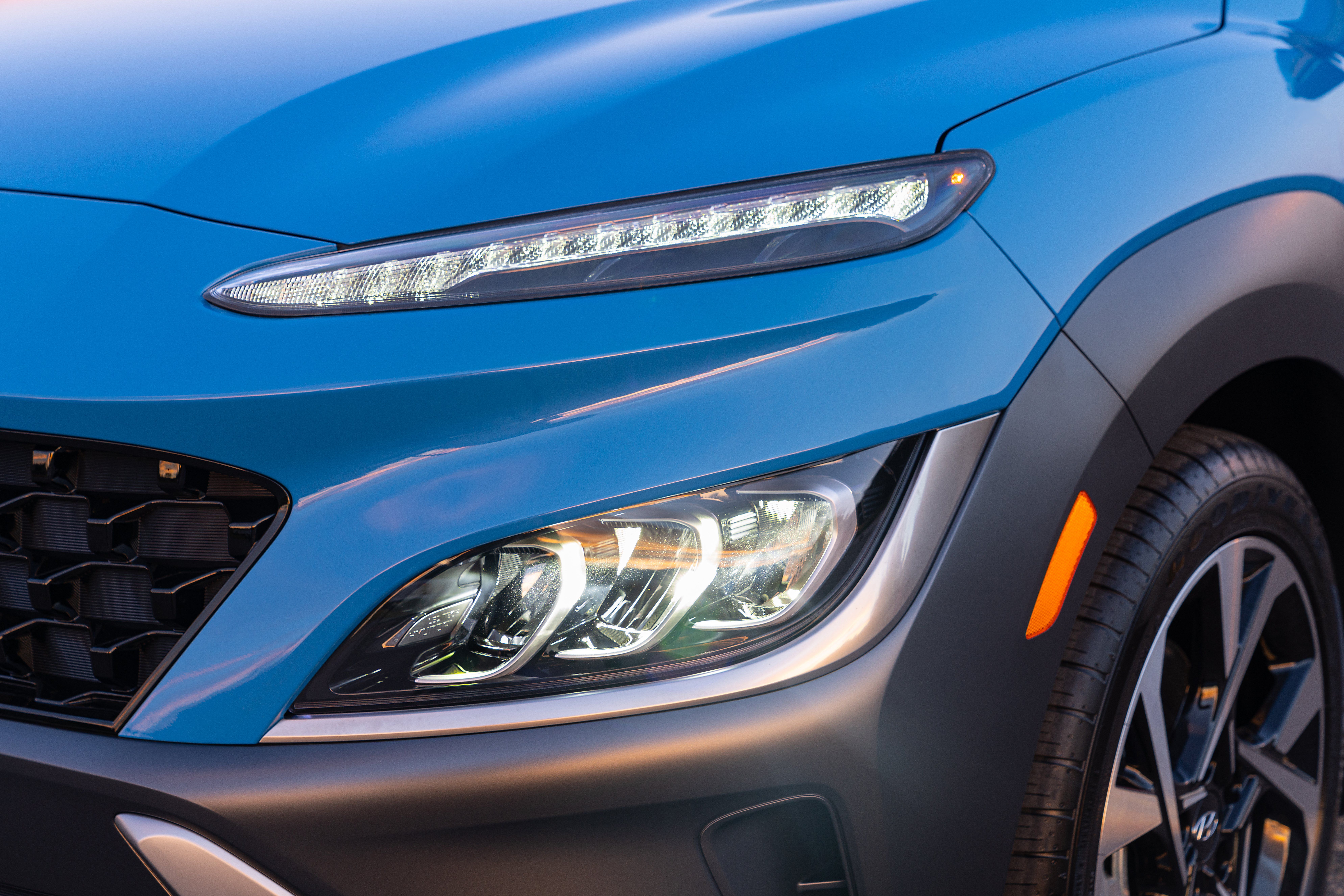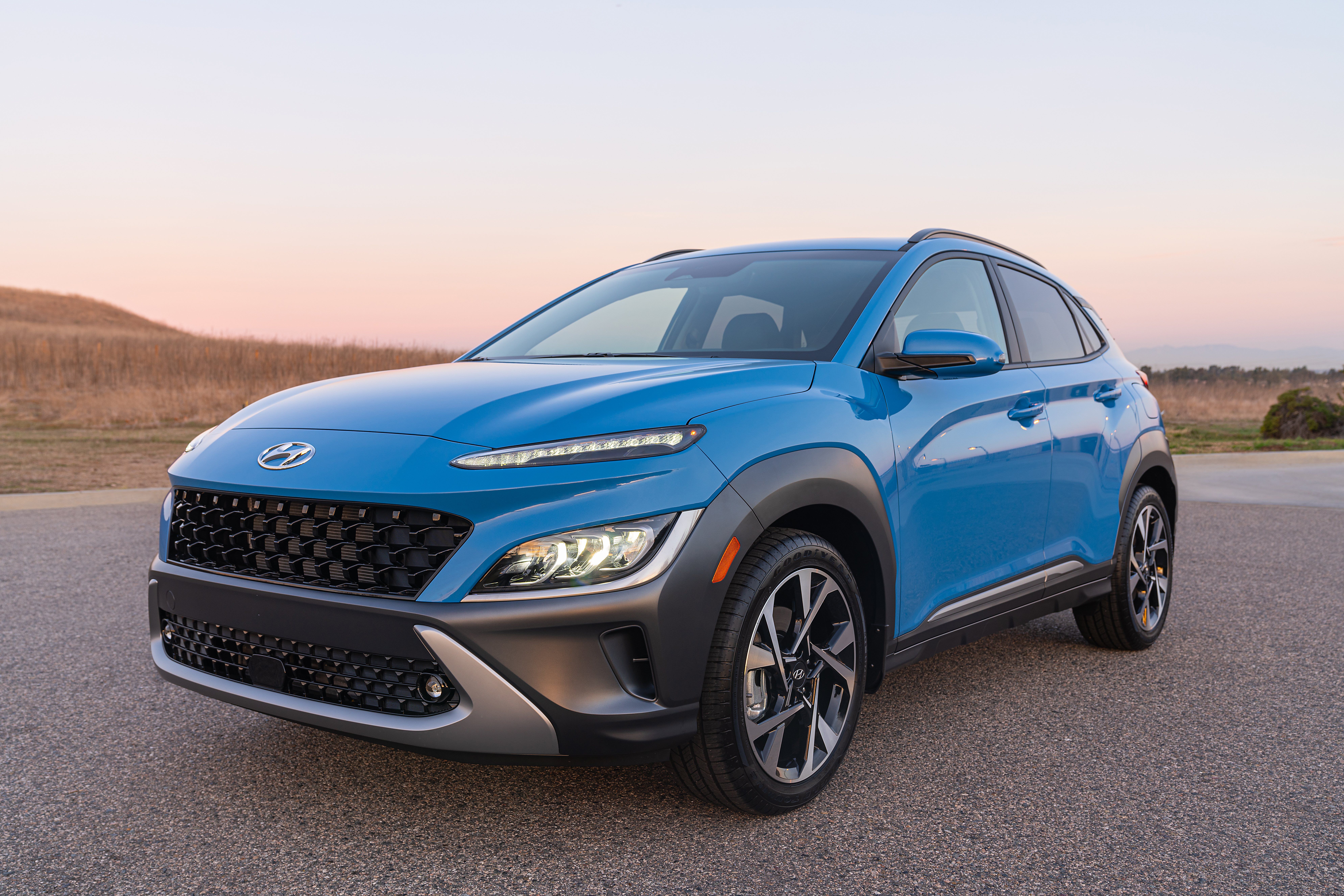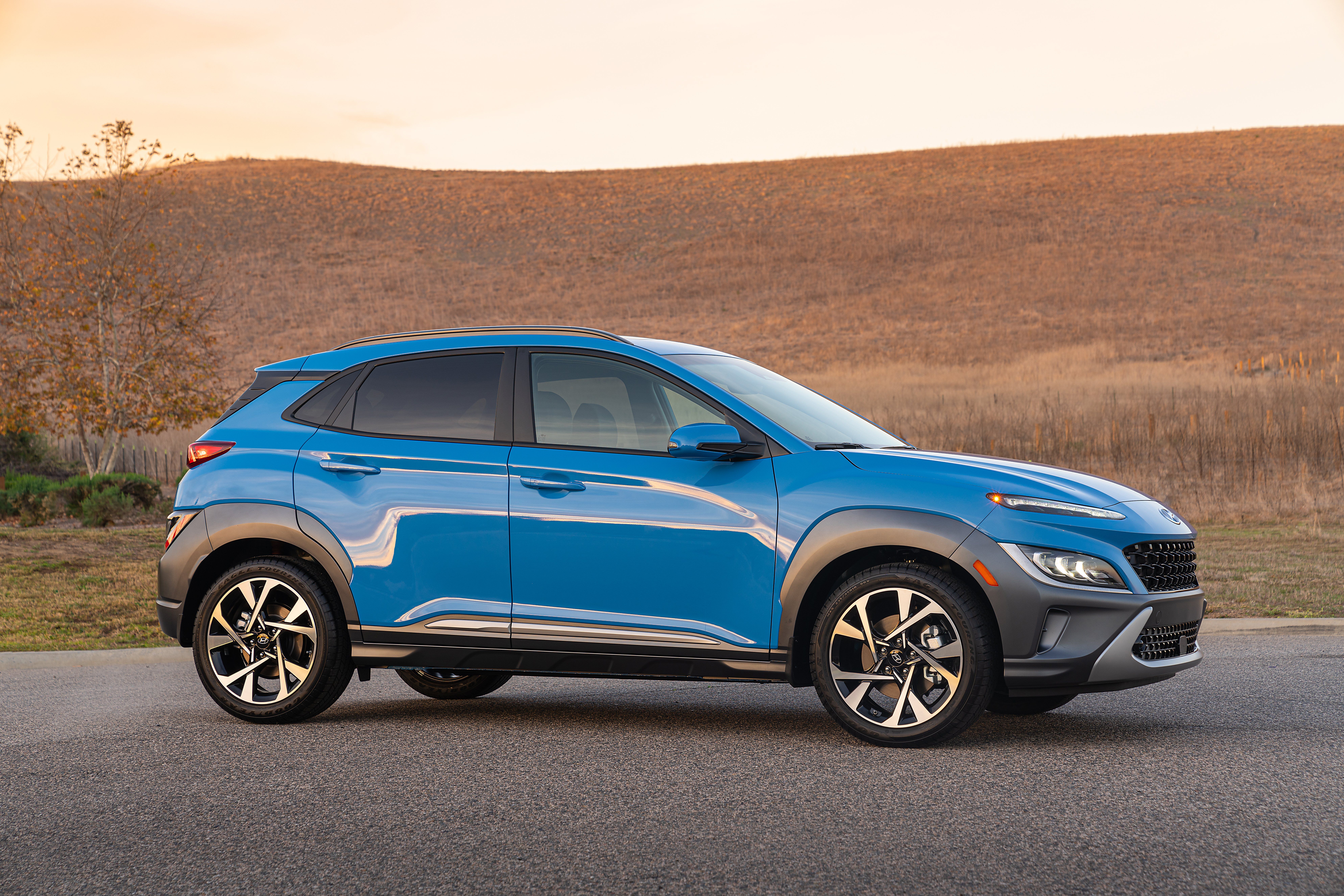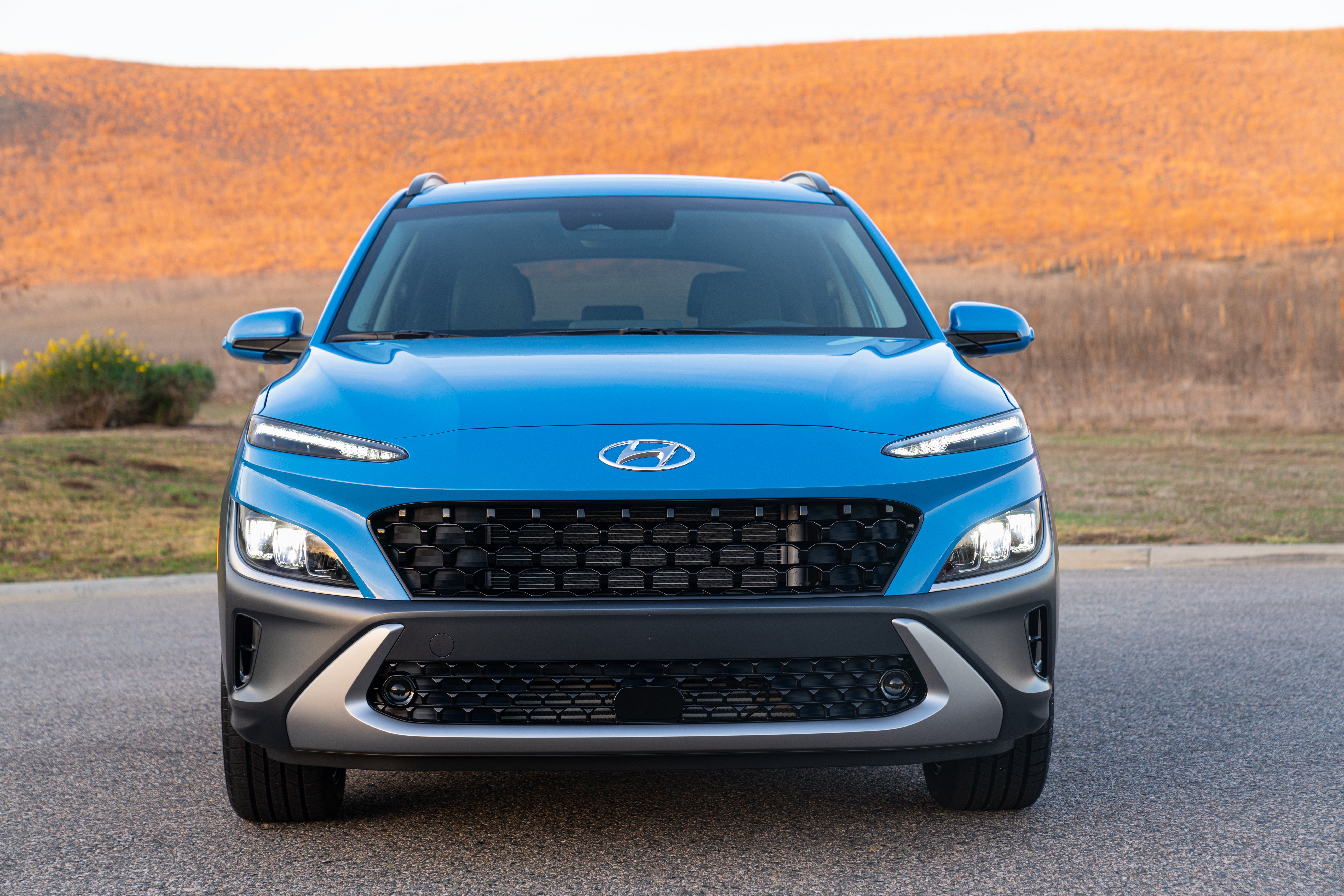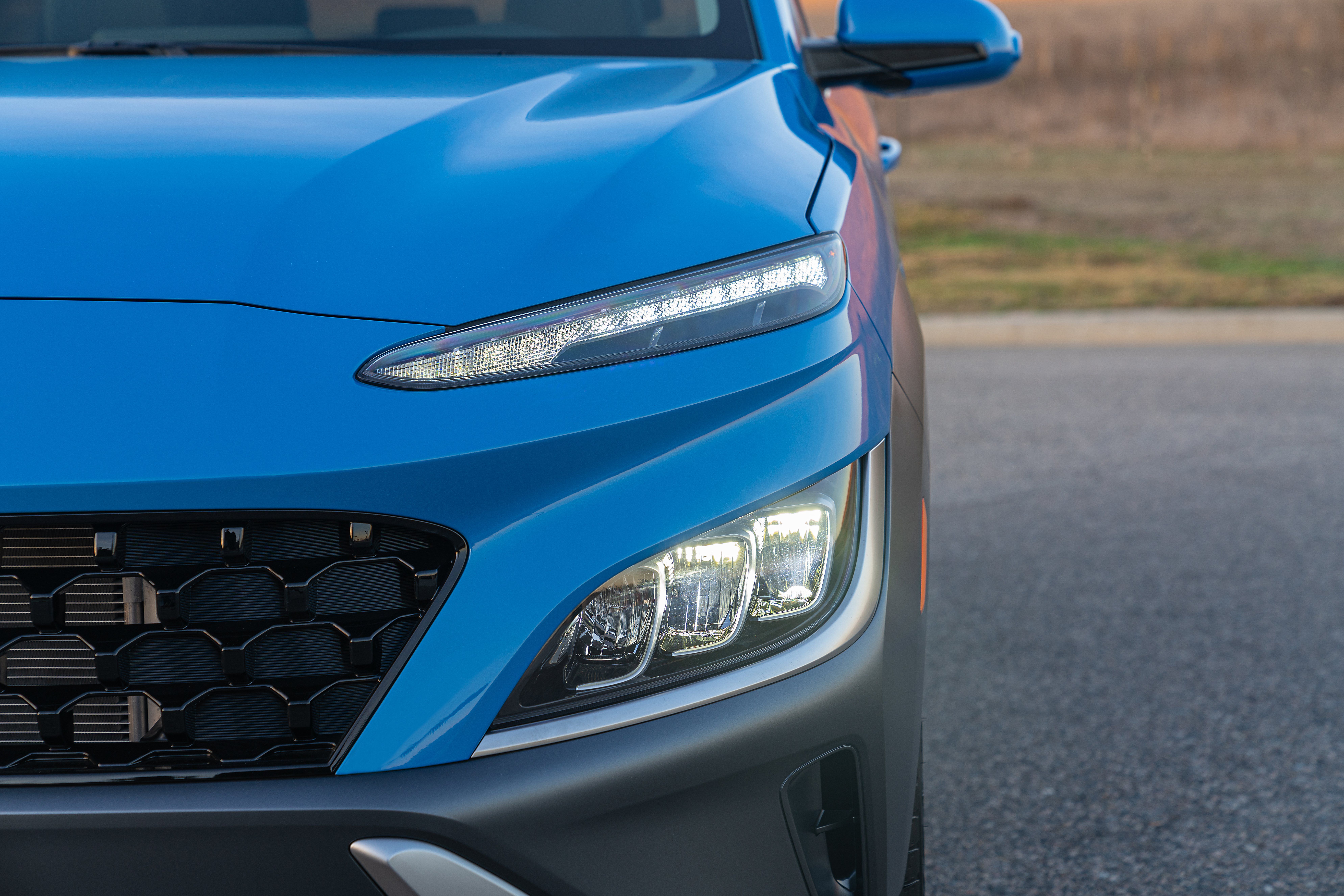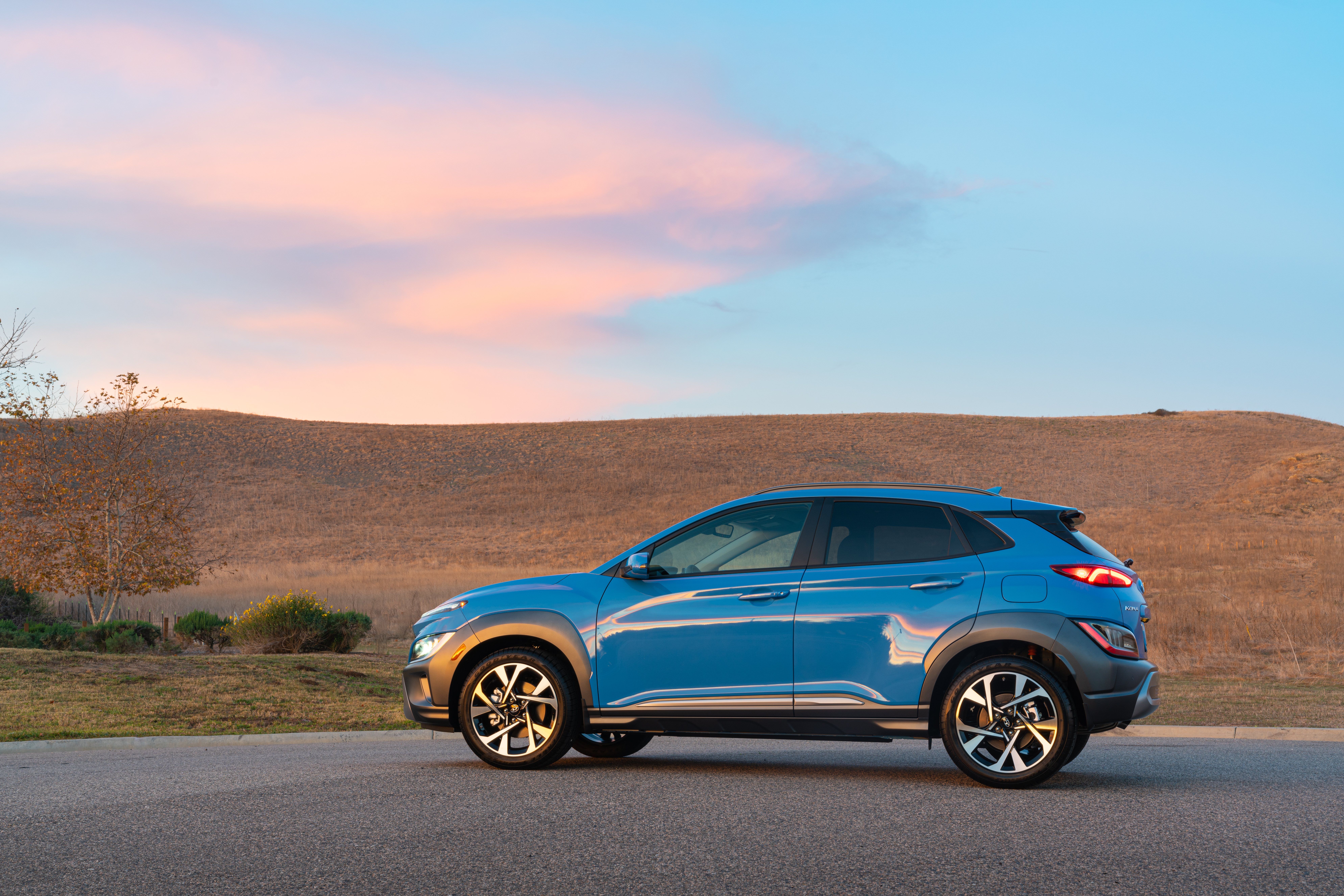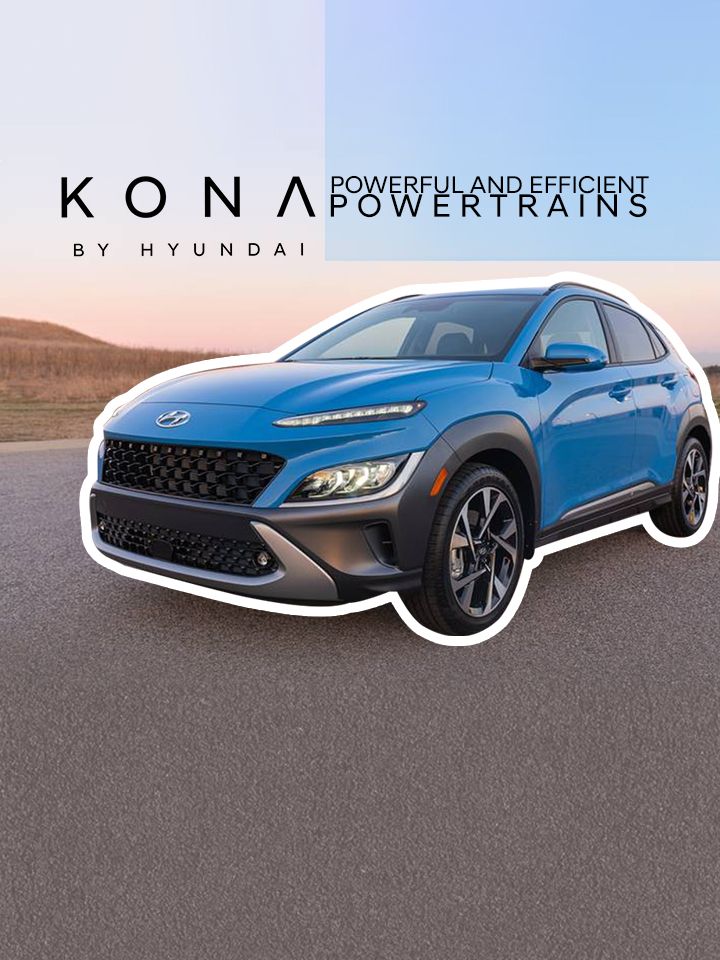Arriving with significant updates both to the exterior and interior, the new 2022 Kona brings hope not only to younger buyers but also enthusiasts with the newly added Kona N Line and N. While the looks and the aesthetics have taken a sharper appeal, the mechanics have stayed the same, except for the addition of a CVT to the base engine. We think that the new Kona is a breakthrough in how compact SUVs should look and feel, but, should you buy one?
2022 Hyundai Kona
- Make: Array
- Model: 2022 Hyundai Kona
2022 Hyundai Kona
- [do not use] Vehicle Model: Array
Overview
Hyundai has been successful in the U.S. market for offering a better price-to-performance ratio and with the new 2022 Kona, things will get even better. The new Kona arrives with updated exterior and interior design and a lot of necessary updates which are truly admirable. With the 2022 model year, we will witness the N-Line and N trims which are Hyundai’s performance division’s rework of the Kona. If you remember, we reviewed the 2022 Elantra N which is a true performance monster for its cheaper price tag. The Kona N Line and especially the N are for the enthusiasts for whom the instant torque is needed with the best of Hyundai’s handling wizardry. The standard 2.0-liter naturally aspirated engine remains unchanged as is the 1.6-liter turbocharged four-pot, but the latter is more powerful since it is powering the new N-Line. As for the upgrades, there is a bigger eight-inch touchscreen infotainment display and now the system supports wireless Android Auto and Apple CarPlay connectivity. A bigger 10.25-inch driver information display along with a similarly sized infotainment screen has been made available for the higher trims. Hyundai has also updated the driver assistance features with adaptive cruise control with stop & go, rear automatic braking, and lane-keeping assist. For the starting MSRP of $21,150, the Kona brings a lot of hope for the compact crossover market but can it be any better than the Volkswagen Taos, Mazda CX-30, or the Honda HR-V? We will try and clear everything before you settle for any of them.
Trims and Features
Hyundai decided to shorten the trim list and has added two new performance-oriented trims: N Line and N. So now, there are five trims in total: SE, SEL, N Line, Limited, and N. The base SE and SEL are powered by a 2.0-liter naturally aspirated inline-four engine which is mated to a CVT and are FWD as standard. AWD is available as a standalone option. The N-Line and the Limited have the 1.6-liter turbocharged inline-four, but the engine puts out more power and torque compared to the outgoing model year. The new wolf in the pack is the Kona N. The Kona N is a straight-up performance crossover and sports a 2.0-liter turbocharged engine that puts out up to 286 horsepower and 289 pound-feet. That said, here is a detailed trims and features list for your convenience.
SE. } }
Price: $21,150.
- 16-inch alloys.
- Continuously variable transmission.
- Manually adjustable driver and passenger seats.
- 8-inch touchscreen infotainment display.
- Apple CarPlay and Android Auto wireless connectivity.
- Six-speaker audio unit.
- Optional AWD for $1,500.
Standard driver assistance features include:
- Lane-departure warning.
- Lane-keeping assist.
- Forward collision mitigation.
SEL. } }
Price: $22,950.
- Remote engine start.
- Heated exterior mirrors.
- 17-inch alloys.
- Tinted windows at the rear.
- Keyless entry and engine start.
- Roof rails.
- Satellite radio.
- Rear cross-traffic alert.
- Blindspot monitoring.
A few of the standalone features available for the SEL are:
- Dual-zone automatic climate control.
- Wireless charging pad.
- Sunroof.
- Leather-wrapped steering wheel.
- Heated front seats.
N-Line. } }
Price: $25,700.
- 18-inch alloys with unique wheel design.
- Seven-speed DCT.
- Dual-zone automatic climate control.
- Heated front seats.
- Wireless charging pad.
- Leather-wrapped steering wheel.
- 10.25-inch driver information display.
- Cloth upholstery with sport front seats.
- Power-adjustable driver seat.
N-Line w/ Tech package. } }
- Sunroof.
- 10.25-inch touchscreen display.
- Eight-speaker Harman Kardon audio unit.
- Navigation system.
- Adaptive cruise control.
Limited. } }
Price: $28,450
- Both Convenience and Tech packages.
- Automatic wipers.
- Leather upholstery.
- Power lumbar support for the driver’s seat.
- Upgraded soft-plastic interior trim.
- USB ports for the rear.
- 18-inch alloys.
- Auto-dimming rearview mirror.
- Adaptive cruise control.
- Rear parking sensors.
N. } }
Price: $30,000 (Expected)
- FWD only.
- Eight-speed DCT.
- Features from the Tech package except for the sunroof and adaptive cruise control.
- Electronic limited-slip differential.
- 19-inch alloys with performance tires.
- Aero-enhanced body kit.
- Performance brakes.
- Variable sport exhaust.
- Leather and suede upholstery.
- Blue interior accents.
- Selectable driving modes.
Exterior: First impression is the best impression
We wouldn’t like to take home a car that looks sharp and sleek? We mean, the Kona is no sports car but the 2022 model year brings a lot of exterior design changes and added flair to its sharper looks. The front end has been reworked to give a more modern look. The LED DRLs are narrower, contributing to a meaner look. The LED headlamps are situated on the lower sides, similar to the outgoing model year but have been redesigned too. The most noticeable difference between the new Kona and the outgoing model year would be the split but enlarged intake grille and the slightly stretched hood. Both the front and rear have skid plates with fake side-intake vents. However, the Kona N gets active side vents which will help cool down the upgraded brakes.
From the sides, you will witness a rather compact length of the crossover but in numbers, there is an increase of 1.6 inches in the overall length. The huge wheel arc claddings give the Kona a rugged look. 16-inch alloys will be fitted to the Kona as standard with the SEL getting the 17-inch ones and the N-Line will have the 19-inch alloys. Coming to the rear, nothing much has changed since the outgoing model. We get to see the same sleek LED taillights and the fake exhaust diffuser with twin tailpipes. Overall looks of the Kona are futuristic and definitely stand out in the competition.
The new Kona weighs 2,899 pounds with the FWD and is among the lightest in the competition similar to the Honda HR-V. However, it is the most compact in the segment with just 165.6 inches body length. The Volkswagen Taos and the Mazda CX-30 are the longer ones while the HR-V is just behind them with 170.4 inches of overall length. The Kona sits 6.7 inches above the ground, and will not deliver the offroad experience you would expect and the CX-30 along with the HR-V has a much better ground clearance of up to 8 inches. The Kona and Taos have a very similar wheelbase of about 102 inches while the CX-30 and Taos can go about 106 inches.
2022 Hyundai Kona Exterior Dimensions
|
Model |
2022 Hyundai Kona |
|---|---|
|
Curb Weight |
2,899 lbs. |
|
Length |
165.6 in. |
|
Width |
70.9 in. |
|
Height |
61.0 in. |
|
Ground Clearance |
6.7 in. |
|
Wheelbase |
102.4 in. |
Interior: A step up from minimalistic to a sophisticated cabin, but only if you are willing to pay more
While the cabin design is majorly untouched, there are a few changes that you will instantly notice. The first thing would be the standard infotainment display size has been increased to eight inches. The circular air vents have a turbine-like design now, but a few would notice the difference. However, Hyundai is offering a 10.25-inch driver information display and a 10.25-inch touchscreen infotainment display for an extra bit of money. It might be a bit costly for your preference, but the experience would be great. The driver information display has a few layouts that change with the selected driving mode. Both the optional displays are good with colors and offer crisp visuals. As standard, there will be a 4.2-inch digital display fitted in the middle of the analog dials. The only downside of this cabin would be the unwanted use of hard plastics. Yes, we all hate plastics, especially the harder ones but it’s not Hyundai’s fault completely. The attractive price tag is the result of immense cost-cutting.
Apart from the optional screens, everything stays the same. The steering wheel comes leather-wrapped with manual tilt and telescopic adjustability. Manual seat-adjustability is what you are going to get in the lower trims unless you opt for the N-Line, Limited, and N. The steering wheel that comes with the N will have two N-specific buttons to summon the sportiest drive mode along with a track-focused interface on the infotainment screen. The N also has blue accents inside the cabin to remind you that you are driving the top-tier performance Kona. That’s it for the design. The seats are very comfortable even when they are cloth-covered. The optional leather upholstery will bring better comfort and longevity. Features like heated seats, power-adjustable front passenger seats are available as an option for the base trim.
How about the cabin’s spaciousness? Well, it is kind of a mixed bag. The front row has ample headroom with up to 39.6 inches and a good 41.5 inches of legroom. Both the driver and the front passenger will be seated comfortably, which will make the rear seats a bit cramped up. With the aforementioned length of the new 2022 Kona, it is expected to be compact even inside the cabin. So you are looking at a decent 37.8-inch headroom but mediocre 35.2-inch legroom. Nothing troublesome, but if you have someone taller in your family, they might get a bit annoyed on the long highway drives. If you are concerned about rear passenger comfort, then you should look for the HR-V which has a lot of legroom, 39.3 inches to be precise. The Volkswagen Taos has good 37.9-inch legroom and a segment-leading 39.8-inch rear headroom. But, the Kona is a lot compact in size, remember? That brings us to the final nail in the coffin, the cargo capacity. The Kona can pack only 19.2 cubic feet, which is not unusable or something, but the 27.9 cubic feet from the Taos seems to be a huge deal-breaker. Before we discuss the infotainment system, here are a few interior features for an easy recap:
- Dual-zone automatic climate control.
- Power-adjustable driver seat with power lumbar support.
- Optional leather upholstery.
- Heated front seats.
- Leather-wrapped steering wheel with paddle-shifters.
- Auto-dimming rearview mirror.
- Optional 10.25-inch driver information display.
2022 Hyundai Konda Interior Dimensions
|
Model |
2022 Hyundai Kona |
|---|---|
|
Seating Capacity |
5 |
|
Front Row (Headroom/Shoulder Room/Leg Room, in inches) |
39.6/55.5/41.5 |
|
Second Row (Headroom/Shoulder Room/Leg Room, in inches) |
37.8/54.5/35.2 |
|
Cargo Capacity |
19.2 cu.ft. |
Intuitive systems are becoming rare these days as manufacturers are busy investing in new tech for more sophistication. Meanwhile, companies like Hyundai are maintaining a standard for general intuitiveness for operating the infotainment system. The Kona sports an updated eight-inch display sitting atop the dashboard that is assisted by easy buttons and the responsiveness is quite good for a budget crossover. However, there is an optional 10.25-inch display if you want the best experience. As standard, a six-speaker audio unit comes fitted as well as wireless Android Auto and Apple CarPlay connectivity. A few of the other features available with the 2022 Kona are as follows:
- Navigation system.
- Satellite radio.
- Wireless charging pad.
- Eight-speaker Harman Kardon audio unit.
- WiFi connectivity.
Performance and Handling: The usual suspects, but got peppier
While the base engine remains untouched, the slightly more powerful 1.6-liter engine now delivers more power than the outgoing model year. So there is a 2.0-liter naturally aspirated inline-four which has a rated 147 horsepower and 132 pound-feet. The engine is mated ts a continuously variable transmission that Hyundai calls Intelligent Variable Transmission which, in our opinion, is smarter than a normal CVT. FWD comes standard with the base engine, while AWD remains an optional add-on. For the N-Line and Limited, you are looking at an upgraded 1.6-liter turbocharged engine that delivers an amazing 195 horsepower and 195 pound-feet, available at 4,500 RPM. The power has been increased for the introduction of the N-Line trim, so there is an extra 20 horsepower. Also, there is a retuned seven-speed dual-clutch automatic transmission backing up the engine and according to driven reviews, the shifts are much faster and more accurate in low-speed driving. The only nitpick with the transmission would be its tendencies to upshift autonomously even in manual mode. The 2022 Kona will witness another savage 2.0-liter turbocharged engine that will power the Kona N with a rated power output of 276 horsepower and 289 pound-feet. The engine can give a boost of up to 10 horses extra for about 20 seconds, making you howl for your mother. (Just kidding).
How about real-world performance? The base engine with FWD guise does 0-60 miles per hour in 9.2 seconds. That is slow but, you wouldn’t care about it at all for the great mileage figures but more on that later. The N-Line powered smaller 1.6-liter engine has all the torque available just from 1,500 RPM and coupled with the DCT for smoother transmissions, you are looking at a 0-60 miles per hour in 7.3 seconds, according to Car And Driver testings. Handling-wise, we don’t think that the Kona would be any different than the outgoing model year. But the N-Line and the N would be a hell of a crossover, mainly for taking in and out of the corners. The N-Line has a slightly stiffer front suspension but misses out on the electronic limited-slip differential which the Kona N has. The Kona N will have better braking performance and altogether, the 2022 Kona is the only crossover in its segment to offer so much versatility with such a reasonable price tag. We have not got a taste of how it drives, but will surely update you when we do.
2022 Hyundai Kona Performance Stats
|
Model |
2022 Hyundai Kona |
2022 Hyundai Kona N Line |
|---|---|---|
|
Engine Type |
2.0-liter naturally aspirated inline-4 |
1.6-line turbocharged inline-4 |
|
Drive Type |
FWD/AWD |
FWD/AWD |
|
Transmission |
Continuously variable-speed automatic |
7-speed shiftable automatic |
|
Power |
147 hp @ 6,200 RPM |
195 hp @ 6,000 RPM |
|
Torque |
132 lb-ft @ 4,500 RPM |
195 lb-ft @ 4,500 RPM |
|
0-60 (mph) |
9.2 seconds |
7.3 seconds |
|
Quarter-mile |
- |
15.7 seconds |
|
Top Speed |
130 mph |
130 mph |
Fuel Economy
The Kona with the base engine has a lot less raw power if you compare it to the likes of the CX-30 and Taos but the EPA ratings will make you happy anyway. 30 miles per gallon in the city, 35 miles per gallon on the highways, and a combined economy of 32 miles per gallon. It is strange to see the HR-V underperforms the Kona, even when the base engine is slightly less powerful than the given standards. What is more interesting is that the N-Line’s 1.6-liter turbocharged engine gets a mile less than that of the base engine, according to the EPA, but the highway and combined mileage figures are the same. The tank capacity is a generously sized 13.2 gallons and will possibly return about 460 miles on the highways.
2022 Hyundai Kona Fuel Economy
|
Model |
2022 Hyundai Kona |
2022 Hyundai Kona N Line |
|---|---|---|
|
MPG (City) |
30 |
29 |
|
MPG (Highway) |
35 |
35 |
|
MPG (Combined) |
32 |
32 |
|
Tank Capacity (Gallons) |
13.2 |
13.2 |
|
Range (City, Highway, Combined) |
396.0/462.0/422.4 |
382.8/462.0/422.4 |
The 2022 Kona has a few of the modern driver assistance tech fitted as standard but you can unlock all of them by paying extra cash. Lane-departure warning, automated emergency warning, lane-keeping assist, and driver attention warning come fitted as standard but some more advanced driver assistance features which can be opted optionally are:
- Adaptive cruise control with stop & go.
- Rear cross-traffic alert.
- Blindspot monitoring.
- Rear parking sensors.
Should you consider the 2022 Hyundai Kona over the competition?
The new 2022 Kona is a more advanced and refined version with loaded tech, meaner looks, and enough performance with the N-Line and N. Seeing it priced below $23,000 makes it one of the cheapest crossovers with more than adequate features and reliability. The competition is not weak, to be honest. Both the Mazda CX-30 and Volkswagen Taos are powerful but the latter uses a turbocharged engine as standard, meaning the torque is available in the lower rev-band. So, the Taos has better performance from the get-go, unlike the other options which you have to rev hard to churn out every bit of power. For the performance enthusiasts, the N-Line and N is an absolute win because no other compact SUV in the segment would offer the price-to-performance ratio as Hyundai did.
How much power does the Kona N produce?
Does the 2022 Kona have a multi-information display?
Does the Kona come with the AWD?
FAQ
Q: How safe is the new 2022 Hyundai Kona?
{{The 2022 Kona would perform no less than that of the outgoing model year which bagged a full-on 5-star rating by the NHTSA along with the “2021 Top Safety Pick” award by the IIHS.}}
Q: How much power does the Kona N produce?
The top-of-the-line Kona N sports a 2.0-liter turbocharged four-pot that allows 276 hp and 289 lb-ft. However, the engine can build a 10-hp boost for better straight-line accelerations.
Q: Does the 2022 Kona have a multi-information display?
Yes, the 2022 Hyundai Kona can be fitted with the fully digital multi-information display as an optional add-on.
Q: Does the Kona come with the AWD?
Yes, the 2022 Kona can be equipped with an AWD system even with the base engine and the N-Line for added traction but is about $2,000 dearer.
Q: How fast is the 2022 Kona?
The Kona N being the fastest among the bunch is predicted to achieve 0-60 mph in 5.5 seconds and tops out at 149 mph.

